The Internal Comms Podcast

Episode 77 – Here for the culture
This week on The Internal Comms Podcast, host Katie Macaulay welcomes culture-chameleon Shane Hatton. Shane is many things – author, international speaker, trainer, leadership coach, podcast host… but he best describes his journey as “a long collision of marketing, leadership and psychology.”
Shane is the author of Lead the Room and Let’s Talk Culture, two fascinating books that get to the crux of how leaders can step up and lead ‘“in the conference room, the meeting room and the lunchroom,’” and the importance of this in building company culture.
Lead the Room originally began as three leadership programmes blended into one; there’s a thread that runs through this conversation of how many things come together to create magic. It’s jam-packed full of anecdotes that will make you rethink what culture really is and how (or if) it’s created and cultivated.
From one team culture built on the back of a story about failure at Olympic try-outs, to a story that begins “Hey Katie, would you mind just jumping in the car with me?” Shane’s unique way of approaching culture through storytelling is a real tonic. It’s not one to miss.
We hope you enjoy this latest episode. If you have any thoughts or comments on this episode, share them using the hashtag #TheICPodcast. For more exclusive IC insights, follow us on Twitter at @abthinks.
Transcript
Katie 00:03
The Internal Comms Podcast is brought to you by AB, the world’s first specialist internal comms agency. For nearly 60 years, AB has worked hand in hand with internal comms leaders around the world, to inform, inspire, and empower their workforces, building great organisations from the inside out.
Katie 00:30
If you’d like to discuss new, effective, exciting ways to connect with your people, please get in touch. Visit abcomm.co.uk. And if you do, I look forward to meeting you. And now on with the show.
Katie 00:51
Welcome to The Internal Comms Podcast, where it is my privilege to explore ways we can make communication at work, work. I’m Katie Macaulay, and I’ve dedicated a career to helping organisations better hear, inform, involve, and ultimately inspire their employees. I’m going to keep my preamble short for this episode, because it’s just so good. I can’t wait for you to hear it.
Katie 01:25
Shane Hatton is many things: an author, international speaker, trainer, coach, and also a podcast host himself. But most importantly, for this conversation, which we managed to record in person, Shane uses his background in business, psychology and communication to help organisations around the world develop remarkable leaders and remarkable cultures. Having read both of Shane’s books as preparation for this show, Lead the Room and Let’s Talk Culture, I thought this conversation would be pretty good. But genuinely, it completely exceeded all my expectations. I hope you find it as informative and thought provoking as I did. So without further ado, I bring you Shane Hatton.
Katie 02:25
So, Shane, welcome to The Internal Comms Podcast.
Shane 02:29
It’s so nice to be here and be in person, not on Zoom!
Katie 02:31
I know, what a treat for both of us. I have read both your books, loved them, really excited to talk to you about both of them, particularly your latest book, Let’s Talk Culture. In that you talk about your journey. And you write “my journey is best described as a long collision of marketing, leadership and psychology.” And I was just wondering if you could share with us how that career journey evolved, what led up to that collision, and what that collision looks like in terms of the work you do practically on a day to day basis.
Shane 02:35
I think collision is a good word because it feels chaotic. I think that’s probably the way that the word collision resonated for me. I think if you go back and look at my career journey, do you find that there’s journeys that you go on, nothing makes sense, as you’re doing it until you look back and you see all of the things seem to somehow align to what you’re doing now? That definitely describes kind of my career journey.
Shane 03:30
So when I finished school, I remember not knowing what I was going to do with my future. And I was actually doing an electrical apprenticeship in Australia. And I was out there working wiring houses, and it was kind of this workspace. I lasted for weeks in that work experience and realised I never want to do that with my life. But it was around the time where applications to university was closing. And I said to my girlfriend at the time, who’s now my wife, we’ve been married for 15 years. I said to her, “what are you doing with the rest of your life?” And she said, well, I’m thinking of going to university and studying business. And I said, “could you just enrol me in that because I have no idea what I want to do.” And so that’s why it felt very chaotic. It felt very colliding.
Shane 04:07
But I found myself in business, and just was attracted to marketing. And so I went and did my degree in marketing. And it was just something about messaging. It was something about connecting language to people. And that really kind of triggered this, I guess, fascination with communication. But then when I left university, I was working in a marketing job and I worked in an event management job. I was working for local government and I was coaching community leaders how to run community events. And that was involving gathering groups of people and volunteers, coaching volunteers, mobilising them around a key idea or a movement. And I never fully understood how that connected to anything that I was doing.
Shane 04:44
So fast forward to what I do now. I now help people capture ideas and messaging and mobilise people around those ideas, and then build cultures that make people want to stay and be a part of those ideas. And so, all through my career I’ve had these moments. Now I went on and worked in other jobs, I worked in communications in a not for profit, I worked in student recruitment in a university. So all these things, it was all about marketing, it was all about communication, it was messaging, it was culture, it was coaching, and all of these things I just feel like collided to the work that I do now. So it was never planned. But it’s all ways been really helpful.
Katie 05:18
I’ve had other guests say, Yes, ‘life is lived forward, but understood backwards.’
Shane 05:24
That’s a much simpler way of saying what I just said, Yes, I will say that in the future, I think.
Katie 05:30
But it’s interesting, isn’t it, because it means for listeners who may be feel they haven’t got that really clearly crafted plan of where they go next, and where they go after that. Actually, your story is suggesting that you don’t need that necessarily. Possibly, what you need to do is just make the most of every opportunity and find the thing that you’re passionate about in the thing that you’re doing, because that will probably guide you on to the next thing, if that makes sense.
Shane 05:55
Yeah. I have a mentor who sat down with me. And he drew three circles on a page. He was recruiting for a CEO at the time. And he said, “Shane, the things that I look for in a CEO are these three”, he said “it’s experience, it’s expertise and it’s essence.” And he said, “two people could have the same experience but they take away very different expertise. But they also have very different essence.” And so when I’m looking at my career trajectory, and the kind of work that I’ve done, it’s not just experience, I must say, so what did that teach me? What did it, what I learned from that? And what expertise can I gain from that? Who did it shape me to become so that my essence is who I am? And so I always think that those three things now whenever I’m looking at my work, I’m like, it may not make sense now. But what’s the expertise I can draw from this? And how has it shaped the person that I’m becoming?
Katie 06:39
Let’s start with your first book Lead the Room. When we spoke previously, I think you explained that Lead the Room began as a management development programme, am I right? This is the origins of the book. And I think it was about how to enable people to move from a fairly senior level, but to a much more senior executive level. Is that but is that the origin?
Shane 07:04
The origin? Yeah, it actually started as three programmes blended into one. And it came because a HR leader reached out to me and said, “we’ve got this layer of leaders that are senior level managers, but haven’t been able to make that jump to an executive level leader.” As a result, they’re recruiting externally. And when you recruit externally, you dilute the culture that you have, you have to kind of lose some of your organisational knowledge. And yes, there’s advantages, but you lose some of that real development pathway. And she said, “Shane, could you help us create a programme that would help people make that jump?” And she said, “What are the core skills you think people need in order to be able to make that jump?” And I thought about it for a moment and kind of reflected on my experience, expertise and went, you know what, I think there’s three things that help people navigate that jump. And I used it as a metaphorical space. And it was a room at the time. And I said, “I think leaders need to know how to lead in the conference room, the meeting room and the lunch room.” And that’s really where Lead the Room started.
Shane 07:59
And the way I unpack that is, leaders need to know how to lead in the conference room, which is those most obvious moments of leadership. It’s the ones where you’re standing in front of your staff. It’s a big group environment, it’s public speaking, it’s presenting messaging, it’s vision casting, it’s all of those collective leadership moments. But then there’s the less obvious ones. It’s the individual. It’s in that meeting room. It’s the one on one. How do I coach my team? How do I develop my team? And then the one that feels a little bit more abstract, which is obviously where I went with the second book, which is the lunch room. Which is that cultural leadership. How do I create culture when I’m not in the room? How do I have a culture that’s so strong that everyone knows what’s expected of them when I’m not even in the room?
Katie 08:38
I love that thought. And it’s reminding me of a piece of coaching advice I was given when I first became a Managing Director. And it’s such a simple, it was just a simple insight. And I thought, “oh, Katie, you’re so stupid for not realising this.” But my coach said to me: “never forget, the eyes are on you all the time.” If you get up from your office, in those days, we had offices, and walk across the building, people are watching you. And I don’t know why. But I thought well, I’m, I’m only visible when I’m in a meeting speaking on stage, but you’re not are you? People are looking to you all of the time. In every moment of interaction.
Shane 09:17
One of the things I say to people is, “as you move through different layers of leadership, especially when you’ve got bigger organisations, you can’t see everybody.” One of the things that’s great when you first start your first management, or you might have two or three people on your team, you can meet with them weekly, you can meet with them daily, almost. But then you start to oversee a department. And now you see three to four people. have a team of 20 or 30 people and then you start seeing an organisation. And now I can see again 10 to 12 people out of an organisation of 100,000 people. So you can’t see everybody but you can be seen by everybody. And people are watching. They’re always watching.
Katie 09:51
The focus of that book, I think is really smart and it can be best summed up by ‘intent before content.’ I think when I picked that book up, honestly, I thought this might be another one of those books about how to have shorter bullet points on your slides or how to wave your arms around less or more, or make contact with the audience. It’s much, much smarter than that. And you include a really fabulous quote from Dolly Parton.
Shane 10:20
Wow, source of truth is also true wisdom.
Katie 10:23
“Figure out who you are, then do it on purpose.” What a great line! Can you explain this whole idea of intent before content?
Shane 10:34
Most people I talk to when it comes to either preparing a presentation, something as basic as that, or even writing a book or, you know, preparing a messaging for an organisation. They always sit down and they gather all the information and all the content, and then they go, how do I now distil this down? And they try to add to the kind of equation. And I remember an experience we had a few years back, we were travelling through Italy, we went to Florence. And when we were in Florence, we went on a tour through the museum there and saw the statue of David for the first time. And the tour guide that was with us, told us a story. Now whether it’s true or not, I don’t know. But I liked the story. He said Michelangelo believed that the sculpture was always within the stone. And it was his job to remove all the superfluous material to reveal the statue that was already there. Most of the time, when we think about communication, we think about it as a process of addition: get more information, get more and get more, get all of that content together. And what I try to encourage people to do is strip it back to find that intention: “what do you really want to achieve? What does success look like?” And then remove everything which is unnecessary that gets in the way of that intention being achieved.
Katie 11:38
And the other thing about that is you then under asking questions, like, “do we want our audience to feel excited, involved, concerned? You start with that intention, and what was from it, but always keep in mind, your central focus of what you’re trying to achieve.
Shane 11:55
Yeah, I think you may have read Chip and Dan Heath’s book Made to Stick, that was one of the concepts where I learned about commander’s intent. And I remember reading that in the book in America, and I’ll unpack that for people who haven’t read it yet. I reached out to my friend in Australia andsaid, “Please tell me this is not just an American thing, please tell me this is something much bigger than that.” He said, “No, no, we use it. Absolutely.” And since then, I’ve worked with a lot of emergency services and police organisations, and they use it as well.
Shane 12:20
Commander’s Intent is ultimately a one line statement of success. So for an organisation, like the military, that are conducting an operation, they always want to define what success of that mission looks like, before they start anything else. Once that’s been defined by the Commander, it gets handed down through the ranks and the operational plan, the tactical plan gets attached to that intention. But at any given moment, any single person in the chain of command can go back to the top of the document and see the Commander’s intent. So everybody knows what success looks like. And so whenever I talk about intention, I always ask people, “What do you want people to think, know, feel or do by the end of this messaging presentation, when we get this across?” Because that defines success.
Shane 13:02
So when people hear that I coach presenters, I’ll go and see a keynote speaker, they get off the stage, they go, “how did I do?” What they’re asking is, how did I perform? Was that entertaining? Was I funny? Was I engaging? And the question I asked them is, “what was your intention?” Yes. When they tell me then the next question is, did you achieve that? That’s success. Yes, you can improve your skills. Yes, you can be more entertaining. Yes, you can be more engaging. But did you achieve your intention? Yes, that I think that’s success.
Katie 13:32
The other thing about that Commander’s Intent is also that it’s one line. And how often are we presented with “Yes, what we’re trying to achieve are these seven objectives, nine KPIs…” and you’re lost already. But the idea of it being one single minded idea, concept, I think, is really clever. And everyone can rally around that.
Katie 13:55
Let’s just stick on Lead the Room just for a moment longer. There’s another really great quote, oh, my goodness me, you’ve got a gift haven’t you? These wonderful quotes. This is James Humes is a speech writer for five American presidents. ‘The art of communication is the language of leadership. Every time you speak, you are auditioning for leadership.’ Now, many of our listeners will be responsible for advising leaders about how to be better communicators, essentially. I’m just wondering, and this is really tough question. It’s probably an unfair question. But what is the most powerful piece of advice we can give leaders to become more effective communicators? We’ve talked about intent. Is there anything else that those listening can say next time they’re in the room with their leader, they could give them this piece of advice or something even just to ponder?
Shane 14:51
I love that. I’m still hanging up on the quote, to be honest. It still carries this heavy weight on my shoulders and for people who are listening. They’re probably hearing that going, “Oh, no pressure. You know, every time I speak in public, I’m auditioning for leadership, no pressure.”
Shane 15:06
The thing that I love about this quote is it reminds us that every opportunity to speak is an opportunity to lead. Whether that’s a team meeting, whether that’s a town hall, there are some that are really obvious, but then there’s others, which are less obvious, that every opportunity to speak is a moment to lead people. It’s an opportunity to take people from where they are to where we want them to be. And I think that’s the power of communication.
Shane 15:30
When it comes to giving advice of what we could do, I think typically, when people think about communication, or speaking or leading people with our words, the temptation is to always ask the question, how? So how do I wave my arms around in a way that exerts authority? How do I project my voice? How do I deal with confidence? How do I structure a presentation? How do I have great looking slides? And I think that stuff’s important, but it’s a small part of much bigger picture.
Shane 15:59
More important than how, is who. It’s the leader. And I often use this example. Imagine people who were listening to this, I showed up to your door today. Now, London’s a bit different where we are because nobody has cars. But in Australia, everybody has cars. But imagine if I showed up into your doorstep today, and I just said to you, “Hey, Katie, would you mind just jump in the car with me? I’d love to take you for a drive.” Immediately, you would be like, “No, thank you. I don’t know who you are, I have no reason to get in the car with you.” And if I told you, “Katie, but I’m a really great driver, I’m a sensational driver,” you will say “I don’t care how great you are at driving the car. I don’t know who you are. And I don’t know what reason I have to get in the car with you.” You can be a really good driver, you can be exceptional at your communication skills. But people don’t trust you. You don’t have something valuable to say, you haven’t made a clear intention. So they have no who and they have no one, even though they have a house. And so I’d say the best piece of advice I can give is don’t just focus on on how, focus on who? How can I build trust with my team? How do I build trust in the organisation? How do I become aware that I’m being seen by the people in the business, the way I walk into reception everyday and I say hi to the receptionist, or to our team as I’m walking through the corridors. If I ignore them, if I’m rude to them, and then I have to stand up on a stage and say, “let’s go on on this journey together” and everyone says, “well, I don’t want to because I know who you are.” So who, not just how.
Katie 17:19
And I think the other thing is really important to say is, if you treat PAs or frontline workers as invisible, you just ignore them, you don’t engage with them. It’s not just the disrespect that you’re giving to those in those moments of opportunity where you could have engaged and could have actually kind of moved those people forward with you. You’re missing out on. Other people are watching that behaviour and not liking it too. It isn’t just those immediate people. The reason I love that analogy so much is that also you’ve got that idea of “I might get in a car with you, you’re telling me you’re a safe driver, you’re over time as you you’re convincing me that you are a trustworthy person, but you still haven’t told me the destination, have you?” So that analogy is really clever, in kind of getting the leader to think “Before we set out on this journey this is where we’re going, this is what the end result looks like, kind of where we’re plotting a course to somewhere.” Yeah. Which I think is quite a nice idea to think about as well, actually.
Shane 18:22
Yeah, and giving them a compelling reason. Because I could say, “I’m going to take you for a drive to Edinburgh.” And you might go “well, I don’t want to go to Edinburgh.” But I’ve got to actually tell you, “Hey, here’s why we’re going to Edinburgh, this is why it’s so important. This is why you’d want to get in the car with me, this is the reason that you’d have to get in the car with me.”
Shane 18:39
So I would say it’s almost like three circles in a venn overlapping each other. And right at the centre of all those of who, what and how, is that really compelling sense of leading people with our messaging, I remember working with an organisation and they were rolling out a policy around bullying and how they wanted to eradicate bullying. And they were putting really firm guidelines in place around this. And it was the days of conference calls before Zoom, where it’s just a microphone on the table. And they had all of these satellite offices. And the person who was leading it was on the phone in their main office. And there was a branch that was a satellite office all gathered around a table around the microphone. And this leader steps up and starts saying, you know, “we’re going to eradicate bullying” and they just pushed mute. Everybody in the room said, “This is ridiculous. He’s the biggest bully in our organisation. How can he do that?” It undermined the entire messaging of that because of his behaviour and who he was. And I often say to people, this one phrase ‘reputation speaks long before you do.’
Katie 19:32
But it can work the other way as well. I remember with one of the biggest banks, one of the first gender equality sexual equality campaigns was headed by a guy who’s probably well known for being an ex rugby player, quite a macho approach to business. But he put his hand up and said “no, I want to lead this,” and it was so powerful. So the other way works.
Shane 19:56
Yeah, it’s the who. When we connect with the person then the messaging comes alive. But if we disconnect from the person, the messaging can be world class and it can fall to the floor.
Katie 20:07
Again, just sticking with Lead the Room for a moment, you write “one of the mantras I share with the leaders who have to speak, is simply this: Don’t answer a question that nobody in the room is asking.” I thought that was a brilliant piece of advice.
Katie 20:26
Let’s talk a little bit about listening. What role does listening play in leadership communications? And I was wondering if we could get practical here. have you seen any actual examples or initiatives around listening that you’ve particularly liked?
Shane 20:41
I think the listening component of it plays into the overall messaging piece of this. And let me kind of unpack what I mean by that. When I finished writing Lead the Room, I spent four months teaching people how to speak. At the end of the book, I was invited to participate in a another book that somebody was writing where they reached out to a whole lot of communication professionals and said, “What’s your number one piece of communication advice?” And they put it together in a book. And I just spent four months teaching people how to speak. And I thought about it for a moment. And I boiled it down to this one line, which was that ‘Good leaders know how to speak and great leaders know when not to.’
Katie 21:16
Yes.
Shane 21:17
And for me, there was a power in speaking, but there’s also a power and listening and knowing when not to speak. And so I think about communication as a tension and resolve. And typically, we would go into a presentation or to deliver some messaging with a resolve, or an answer or a solution. But we haven’t first walked ourselves backwards and ask what’s the question that people would be asking? Or what’s the problem that people would be experiencing? As a result of that we walk in, and it’s like that old adage, tell people what you’re going to tell them, tell them and then tell them what you’ve told them. It’s like going to a movie and saying, show them the end of the movie, then show them the movie, then show them the end of the movie, like well, there’s no tension, and there’s no resolve. But the greatest messaging has tension and resolve. But the only way you can fully do tension is to understand problems, to understand pain, to understand questions, to understand challenges, and you can’t understand those without listening.
Shane 22:09
The greatest entry point to communication is through empathy. And empathy is by sitting with people and understanding their stories, understanding their experiences. And so listening is such a vital part to communication. In terms of the practicalities of that. I know that you do a lot in terms of your work, I will be really curious to hear what you’ve seen about the actual organisations that are doing it well. What I’ve seen work well in organisations is actually less about how they’re listening. It’s actually what they do with what they’ve heard.
Katie 22:40
Yes, because people stop giving feedback pretty quickly, when they realise it’s just going into the ether, or somebody’s bottom drawer. Never to be seen again
Shane 22:49
Yeah, or an inbox that’s never checked.
Katie 22:50
Exactly. Exactly.
Shane 22:52
Well, I mean, have you seen organisations that are doing that? Are they doing listening circles? Are they doing think tanks? Are they, how are they engaging with people?
Katie 22:59
One of the biggest listening exercise was an international bank. I’m not going to remember, they branded this listening exercise something. And there is a case study, we will find that case study, listeners, and put it in the show notes.
Katie 23:13
Groups of people, they decided they all had to be on the same level from a hierarchical point of view. But the idea is they would meet in rooms with no agenda at all. And these were just listening circles, you could bring up any issue, any topic. And for my book, I interviewed the person who architected this whole listening campaign, which I think eventually went internationally. And I remember saying to him, “what happened?” And he said, “Well, for the first few months, most people sat there really uncomfortably. They weren’t used to a) having the space, not having the agenda, realising they could speak about anything.” It did take time, and it wasn’t a switch on the wall that they could flick and all of a sudden, spontaneous, genuine feedback and, and conversation would flourish. Once people realised this was serious, it wasn’t going away, they could speak up, it started to happen. But the crucial thing, and I think the thing you’re mentioning here, which we have to come back to, is that someone in the room, protecting people’s anonymity, was recording the issues, the challenges, the solutions, the ideas. And this went into a big system, a very sophisticated Excel spreadsheet. And then they worked on these problems and initiatives, and had that feedback loop going on. So that became meaningful and change resulted at the end of it. What I hear a lot of when I speak to clients, when I talk about listening, they’ll say, “oh, when we have our pulse survey, we have our engagement survey. That’s another one-way communication exercise. That’s still not really a conversation. And what we’re talking about here is really a conversation.
Shane 24:54
I’ve seen so many organisations use different things. They’ve used their engagement surveys with the comments to be able to capture information. They’ve done listening circles. They’ve done small groups. They’ve had their CEO out talking to people. They have had external representation come in so that people can feel that when they don’t feel safe to talk in front of their CEO. They’ve done all these tactics and tools. And they’ve gathered such incredible information and insight and data. And all of that data goes into a presentation to the executive team. And they say, this is how people are feeling, this is what they’re experiencing. And they go and make changes behind the scenes. And then that’s it. And people say, well, we never saw anything as a result of that. And yet, there’s all this change. And so it’s not just listening, it’s actually feeding back to people. What did you do with what they shared?
Shane 25:38
The way I’ve framed it to people is that there’s a difference between letting someone speak and helping someone feel heard. Listening circles, tools, surveys, all those things, let people speak. Doing something with it, taking action and telling people what you did with, that helps people feel heard.
Katie 25:54
Let’s talk about your next book, which is called Let’s Talk Culture. So perfect segue. Now this starts with a story. Some listeners might know about three goldfish. It’s part of a commencement speech by David Foster Wallace, can you share that story?
Shane 26:13
It’s not related to culture. But the story and the metaphor is definitely applicable to culture. It’s a story about two goldfish who are swimming along in a bowl and having a conversation and another goldfish swims in the opposite direction towards them, and says, “morning, boys, how’s the water?” They kind of politely nod and keep swimming on, pause for a moment, look at each other and go, “What the hell is water?” I love that story. I tell it all the time. And it takes us so long for people to register what’s taking place that story in a keynote. So let people sit with that for a moment maybe pause the podcast and reflect on what that actually means.
Katie 26:48
I love it. The reason that’s such a good start to your book is there is this intangibility. There’s this almost amorphous nature about culture, we kind of know it’s important, and we know it’s there. Your research suggests that a lot of people who fundamentally actually can inform and change culture actually believe they can’t they don’t even know how to get a handle on it. Would that be fair?
Shane 27:13
Yeah, we studied 1000 Australian managers. And when I set out on the journey to write Let’s Talk Culture, I didn’t want to give an opinion on what culture was because there’s so many opinions on it. I wanted to look at what the research was telling me about culture. And so we intentionally engaged an organisation to help us run a study of 1000 managers, and not executive leaders and not kind of frontline leaders like right in the middle, like these middle managers, the people who are living it out day to day. And when we ask them, just 3% felt fully confident to be able to build culture.
Katie 27:44
Wow.
Shane 27:45
3% of managers. That was confronting.
Katie 27:49
That’s just incredible. You right, that you’re never surprised when you talk to leaders and hear there is conflict at work. You write :I’m more concerned when they claim there isn’t.”
28:02 Shane
Yeah, because usually when someone says, “oh, no, our team is fantastic. We don’t have any conflict in our team.” Then there’s a good chance there’s conversations that are happening beforehand, it’s under the surface, it hasn’t bubbled up to the surface yet. I have a friend of mine who is in New Zealand, and her name is Alicia Mackay. And we were sitting down having a conversation about great teams. And she said, “Shane, I think great teams have one meeting.” And I was like, “Okay, tell me more.” She said, “I think great teams talk about all the things they need to in the one meeting.” She said, “Dysfunctional teams have three meetings. There’s the meeting before the meeting. There’s the meeting. And then there’s the meeting after the meeting.” Because people don’t feel confident to actually say what they need to say in the meeting. And that’s kind of why when I hear people say, “Oh, we don’t have any conflict on our team, we don’t have any challenges on our team.” When you pull a team together, a team is made up of so many different personalities and backgrounds and experiences. And human beings are so vastly different. When you put those differences in a room together, you can’t help but create some tension or conflict. And we actually need that. Differences are advantages for our teams. But differences need to work.
Katie 29:10
Do you think there is a reason that people leaders feel that sort of emasculation? I’m trying to think of a better word than that, that inability to inform and influence culture? What is it that makes them feel that they can’t do that? Or they can’t see a way to do that? Is that just training?
Shane 29:29
Well, you know, it’s interesting, we asked people how often they were getting training on culture, and people were saying they’re getting training a lot. They were getting a lot of training.
Shane 29:39
The challenge with that was they struggled to understand what culture is. I mean, if you thought culture is being able to have a difficult conversation with someone on our team, and if you see that as an element of culture that if you had crucial conversations training, we had culture training. So I think a lot of people overestimated how much culture training they had, and they just incorporated everything into culture training.
Katie 30:00
Right.
Shane 30:00
When we said, how often are you getting specific training on how to shape culture, very few people were actually getting that kind of training.
Katie 30:08
Right.
Shane 30:09
So I think the biggest challenge is a couple of things. There’s two parts to this. The first is because they don’t understand culture, they don’t see what they do on a day to day basis as having that influence on culture, we asked people who’s responsible for culture in your organisation. And it cascades down from the top. They said, “We believe that the CEO or the head of organisation is responsible for setting the culture, the C suite or the executive team is responsible for leading the culture and people leaders are responsible for addressing cultural inconsistencies, communicating that culture and living it out every single day.”
Shane 30:43
Now, if you look at those things that are actually shaping the culture of an organisation, it’s not telling people what the culture is, it’s not trying to even just live it out yourself. It’s all of those core elements of addressing the inconsistencies, communicating it to people and sharing it with people, By actually living it out every single day, that’s the middle managers, and they’re touching every aspect of the organisation. And so because they don’t see themselves as those people who are influencing culture in that way, they feel very powerless. And so part of the shift is helping them understand what you do every day is actually changing the culture of your organisation.
Katie 31:17
I’ve realised now in this conversation that we have shifted to talk about culture, we haven’t defined it for people. And in your book, if I remember rightly, you have a whole chapter on defining it. But I think at the end of it, you say, “Look, we can spend a lot of time deciding on what the absolute right definition is, we need to move on to actually working out how to build it, manage it, foster it, and all the rest of things.” Probably a more useful enterprise to be doing that.
Katie 31:46
Having said all that, is there a definition that you particularly like? What sticks in my mind for a while, probably about three or four years ago, maybe a bit longer, people would wander around and say, “it’s the way things get done around here.” Or “it’s the way we do things when no one’s looking.” I don’t know. Over to you.
Shane 32:06
Yeah, I mean, I’ve heard it’s the way things get done around here. It’s the soul of our organisation, it’s the vibe of the place. It’s the soil in which our, you know, organisation grows… The answers to those definitions is they’re all correct.
Katie 32:19
Right.
Shane 32:19
So as it stands now, there is no universal understanding of what culture is, there’s no universal definition. And I think that’s what makes culture so confusing for people. When I did the research for the book, it was kind of like the early 90s. I think, before we start getting everyone has an opinion on Google. So looking at academia, there were 54 academic definitions of culture.
Katie 32:37
Wow.
Shane 32:37
And as I sat down, I went, what do all of these have in common? So rather than trying to define what culture is, what does everyone’s universal kind of understanding of culture look like? And there were four things. The first one is every time culture is mentioned in academia, it’s always referencing a collective group. It’s always collective. So it’s not my culture, your culture, it’s our culture. I guess the why that’s important to understand is that if you have a team, you have culture, whether you’ve done something about it or not.
Shane 33:08
So that’s, I guess, something for people to understand who are listening. You might go, “Ah, look, I need to design my team culture.” Like, well, no, you have a culture already. It’s now creating the culture that’s more by choice rather than by chance. So it’s always collective.
Shane 33:22
The second is that there’s two elements, there’s an unseen element, and there’s an observable element. So culture always has an intangible quality to it, which makes it so ethereal and abstract. Because people go point to our values, and seems to point to the walls, you know, you point to your meanings, or assumptions or your beliefs, you can’t point to them, they’re there, they influence culture, but you can’t touch them or feel that. But there’s also an observable nature to culture, when you say, what are the behaviours or our systems and our practices and our policies? They shape culture, but you can point to them, you can touch them, you can feel them.
Shane 33:57
And then the last thing is that culture is is learned. And it’s shared learning. So when we get culture, we learn it by being around other people.
Katie 34:04
Yes.
Shane 34:05
So you can go into a team. And this is typically how culture works. I’ll join a team. And I’ll look at what’s happening around me to try and learn. And so how do I do that? I observe observable behaviours. And I look at what people do. I look at how they treat each other in meetings, I look at how they say hello to each other when they walk in. And I use that observable information to make sense of what I can’t see the unspoken, the invisible, and I got all these people value collaboration, these people value connection, they value these things. So in order for me to belong in the collective, I must also value these things.
Katie 34:38
Yes. The other light bulb moment for me reading your book. And this might sound a bit strange, so I apologise. Was a round expectation. You talk a lot about being very clear about what your expectation is. And I think you even talk about writing those down.
Shane 34:54
Yes.
Katie 34:55
That was for me as a leader albeit of a small enterprise. I thought “Oh, I do have expectations. I don’t think I’ve ever written them down.” And I don’t think I’ve even used the language of “this is what I expect.” Can you just unpick that for us a bit?
Shane 35:10
I would say all of our biggest frustrations or disappointment in life can be boiled down to a misalignment of expectations. So for example, you go to see a movie and someone says, “You should see this movie it’s fantastic.” You see it, it’s miserable. You go, “That was a disappointment.” You go into a team meeting and you contribute an idea. And somebody shuts down your idea and you walk away feeling disappointed, it’s because you expected when you went into that meeting, in that you share ideas that people would build on those ideas that they would add to those ideas, not shut them down. So there was a misalignment of your expectations.
Shane 35:41
The challenge is, we walk around with expectations, like an invisible rulebook that we use to govern our life. And we judge everybody else, according to our rulebook, not realising that their rulebook is different. And so, in Let’s Talk Culture, I talk about making the unspoken spoken, because it’s about bringing out those expectations of one another and framing them as expectations. Because it’s different to say, “Oh, well, I would like somebody to do this,” because it allows the interpretation of preference, or “I’d prefer if you do that.” But when you say, “I expect you to do that,” that allows you to do one of two things, be very explicit with people what you want, or for you to hear it said out loud and go “maybe that’s not helpful.”
Katie 36:22
Yes.
Shane 36:23
So maybe you say “I expect that everybody would be supportive of my ideas.” When you say that out loud, you go, Oh, okay. It’s preferable, I like it when people are supportive my ideas, but do I really expect that every idea that people would support? Maybe I don’t want that. It allows us now to reframe that in a more helpful expectation.
Katie 36:44
Do you think in a world of hybrid working, that we are going to have to get a lot more explicit with culture? We are going to have to sit down and write these things down to be very intentional about the things we need to build. Because all the things you talked about about observable, and it’s so interesting, I don’t think people even realise that doing it necessarily, but we’re soaking up the way things are done, as you say, from the moment you walk into reception, even, and the receptionist greets you and you greet them back, are we going to have to get a lot more intentional than we ever have done?
Shane 37:22
I think we have, to some extent, because of COVID. So I’m not sure what it was like here in the UK. But in Melbourne, we went straight to working from home for a long time. And unfortunately, Melbourne was one of those locked down cities in the world. As a result of that, everybody had to get really clear on their expectations of people. What does it look like when you’re working from home? When I can’t see you, when you’re not around the office, what do we need from you? And this sort of surprised a lot of people, but two thirds of the people that we surveyed in our study said that culture had a moderate or massive, positive impact on culture.
Katie 37:59
Right.
Shane 38:00
Which was so surprising.
Katie 38:01
COVID did?
Shane 38:02
Yeah, what most people, when I talk to senior leaders, they say “COVID killed our culture.” But their middle managers saying “COVID helped our culture,” generally speaking. And when we dug deeper into that I was going, “why are they saying that?” And I think for the first time in a long time, leaders became very explicit about what they wanted of their teams. They increased levels of trust and autonomy by being able to let them work from home. And they showed up more than they ever did before, and communicated. And so yes, it was challenging. Yes, it was hard. And I’m not saying everything about our culture’s became better. But the elements that strengthened culture, trust and autonomy, high levels of communication, explicit expectations, all of those things improved during COVID. And they’re things that we can continue to maintain.
Katie 38:48
I had to guess, Neil Griffiths who’s wonderful, who said, yes, we’re no longer living in a world of a work life balance, but a work life collision. Coming back to that collision word again, we also did see a little glimpse into people’s homes as well. And I wonder if that, I think just added to that sense of humanity coming together. You know, I can’t say as one, this is far too rosy a picture for an awful pandemic. But there was something about us connecting on a slightly different more human personal level as well wasn’t there?
Shane 39:23
Yeah, there was shared experience. There was something… I remember years ago, I was working with a volunteer organisation, and we had experienced a lot in our team. So we’ve experienced really great successes. We achieved some really great goals. And our team had formed and bonded. And then in 2013, one of our team members was taking a helicopter ride through the Yarra Valley and he was killed in a light aircraft crash. And I remember bringing back the team and getting the team together and we went through this journey of grief together.
Katie 39:53
Yes.
Shane 39:54
And there was something about, I would never wish that experience upon anybody, but what It created an our team to have experienced something together in a different way, formed our team in a way that I could never explain. And we’d experienced success, we’d experience achievement. But there was something about this collective grief experience that bonded us in a different way. There was something about COVID, which is a collective grief and trauma. That is, it’s been a horrible experience for so many people. And yet it has bonded people in a way that is really unusual. And it’s different than us having achieved something together. So it’s just been quite an interesting experience.
Katie 40:31
You’re making me reflect on the fact that not all experiences in business need to be rah, rah, rah, super positive, we’ve done it again, let’s celebrate, to be bonding and meaningful. Yeah. And that’s important to remember as well, isn’t it?
Shane 40:48
Yeah, because I think the temptation is to want to move on quickly from failure, or move on quickly from grief or quickly from the things that are less comfortable. There’s a great quote, one of my favourite quotes was from a man who was travelling around New Zealand, interviewing families with children who had additional needs. He finished his journey and he was so inspired by these families, and he said, what I’ve learned of these families as this, they’ve learned to be grateful for the things that they would have given anything to avoid. And the same is true in business. And same is true in your team, there will be people who are listening to this who go, “we’ve had some really challenging experiences. And I would never want to live those experiences again, I would have given anything to avoid them. And yet, somehow, we found something great in those experiences.”
Katie 41:37
You also say, let me get this quote, right. “Before you can have a culture conversation, you need to have a culture of conversation.” We’ve already talked a bit about the listening, but it is coming together, maybe more often, to share how we feel in the moment about something as well. And having and being comfortable and allowing people to do that must be so important.
Shane 42:01
Yeah. And it’s also the, I guess, the foundation of psychological safety that sits around that. I always say to people, “you can only go as deep as your conversations are safe.” And if you think about the depth of a conversation you can go to you will only go to the depth of the safety which the team feels. And so if you haven’t created the safety, which comes through consistency, and time, and bringing the conversation deeper. When you’re ready to have these deep conversations about our culture, and our mission and what we’re working towards, you can’t get to that depth because there’s no culture that sustains that in the beginning.
Shane 42:36
So I always say to people, “before you start having these conversations about culture, start to have a culture of conversations.” There’s simple things you can do, as personal– this is a really practical tip– ask personal, non intrusive questions of your team, when it comes to your team meetings. Give five minutes at the start of your team meeting to ask a personal non intrusive question. And what I mean by personal non intrusive is don’t go “hey, what does everybody think about the politics at the moment? What does it think about religion?” Or all the kinds of sensitive topics. But as people, if you were to think about a characteristic of somebody in your family that you really admire, who comes to mind, and what’s the characteristic? What that allows people to do is to decide how deep they want to share with a group, and it’s not intrusive, or you might– and it’s not about themselves either.
Katie 43:21
Yes, smart.
Shane 43:22
So you could ask a question like, “What for you has been one of your things that life has been teaching you lately?” Now, it could be that you know what, “it’s been horrible weather, I need to pack a raincoat.” Or it could be “We’ve just lost someone in our family, I’ve realised that family is really important.” The thing about a non intrusive personal question is it’s personal, not work related, but it allows the person to decide how much they want to share with the group. And you’ll be you’d be surprised if you just get into a regular routine of asking these person non intrusive questions, you can bring the depth and the safety of those conversations and the vulnerabilities conversations a lot deeper.
Katie 43:55
Really, really interesting. You’re just making me reflect again, because yesterday was Thursday, which is when on a Thursday, at the end of every month, we take everyone out for a drink. And it’s just that moment to get together and…
Shane 44:08
I love that.
Katie 44:09
…talk.
Shane 44:10
What happens on your Thursday sets up everything happening in your work, which I love that you’re making that intention because, there’ll be moments that when you’re having a drink where you’re sitting beside somebody and you go, “Hey, how are you doing?” “Yeah, uh, you know what, it’s been really tough.”
Katie 44:24
Yeah.
Shane 44:24
And when you see them in the office, you go, “Are you doing okay?” That means the world to people.
Katie 44:29
Yeah, it’s really…
Shane 44:29
I really love that.
Katie 44:31
Yeah, it doesn’t sound terribly strategic. But when we think about taking it away, we absolutely can’t do that.
Katie 44:37
Let’s talk a little bit about values and behaviours, because we have touched on this already. And I don’t know whether it’s just me being incredibly stupid. But another lightbulb moment for me was that link between values and behaviours. And maybe that’s where organisations are going wrong. Is that, Yes, we’ve got the values defined, they’re on the wall, we’ve all kind of aligned around them, they seem to fit the business strategy. Yes, we’ve got a programme, maybe for example, of storytelling to kind of bring these values to life. The link that you make really clearly is they’ve got to be translated into behaviours.
Shane 45:18
Yes. So important. I think one of the things that we know, and people who’ve been listening in know, there’s this concept of layers of abstraction or hierarchies of ideas. What it means by that is we get ideas that can be very abstract, and it can move down through layers of abstraction to be very concrete. If we were to look at values and behaviours, they sit at opposite ends of those spectrums. Values sit high in abstraction. So if you talk about collaboration, it’s so wildly abstract. That if I talk about, in meetings, plussing or building on ideas as a behaviour, it’s very concrete and tangible, practical. Expectations sits right in between those two. Expectations is like the middle layer of abstraction.
Shane 46:04
So when we get teams together to define their culture, we always start with expectations. There’s a great example of this, I was talking to someone, I said, “What’s an expectation that you have somebody that you’ve maybe never said out loud?” She said, “I expect that when other people go make a cup of tea, they’d make a cup of tea for me, too.” And I said to her, “Okay, what’s that expectation about for you?” and she said, “collaboration.” It’s the first time, in my life, I’ve ever heard that making a cup of tea for someone is about collaboration. But what she did is she took an expectation, and she chalked it up to an abstraction that it was almost a value of collaboration. But it was, if you went down to the detail of that behaviour, it’s like, okay, when we catch up for our team meetings, and we’re making tea, you know, we’re doing our team meeting, and one person is making tea, we expect that they would, you know, make a cup of tea for everybody. Again, that’s a behaviour.
Shane 46:04
So one of the problems with organisations is that we go really abstract on values. And in doing so we align everybody, because because it’s so abstract, it’s inclusive. But we don’t go concrete into behaviour, so nobody knows how to put it into place. And as a result of that, people, they really hate values. Yeah, I don’t know if your what your experience is like, but people often say values are useless. Don’t have them on your walls. They’re pointless. have you ever experienced that?
Katie 47:22
Absolutely. Absolutely. Because they seem too intangible.
Shane 47:25
Exactly. And that’s the reason. It’s because they intangible, but the values align people. What they need is the behaviours now.
Katie 47:32
Yes.
Shane 47:32
And the behaviours actually look different throughout the organisation.
Katie 47:35
Yes.
Shane 47:35
So for example, if we say in our organisation, we have a culture of autonomy and flexibility. Let’s say we’re working for a bank. If I was working in the IT department of the bank, I could have full autonomy and flexibility in my role, meaning I could work from home 24 hours a day, whenever I want to. And I could say we have a culture of flexibility, autonomy. But if I was working in a branch, and I was behind a teller and I was at a desk, and I was serving customers every day, you can’t work from home. So we can’t say that we have a culture of working from home.
Katie 48:09
No.
Shane 48:09
We need to say we have a culture of flexibility and autonomy. But that looks different in our behaviour from IT to HR to customer service.
Katie 48:16
Exactly.
Shane 48:17
So we need to have the alignment around values, but the flexibility and adaptability around behaviours to make them personal for each department; for each team.
Katie 48:27
Yeah, I really like that a lot. In fact, just this week, I was speaking to a comms manager in an engineering type organisation. And just naturally, he was briefing us on something and he said, “one of our values is operational excellence, which we deliver by continuous learning. So I like the approach of built into this because it’s got that learning loop.” And I thought, “Oh, that’s so clever. You’ve given us the value, and then you’ve given us for your area of the business exactly what it looks like.” And I understand continuous learning, I understand that whole idea of, you know, the sort of the virtuous circle. So yeah, that’s amazing,
Shane 49:03
I think one of the things that people will be concerned about doing that is that they go, “well, if we take a value, like collaboration, the list of behaviours is endless.” And that’s where people can get overwhelmed. And I think the thing about behaviours that are attached to values is they don’t need to stay the same all the time. They kind of rotate in order of priority. So what you can do with your team is you can say, “we want to build a more collaborative culture, let’s decide on three of the behaviours that if we all as a team commit to, would create a more collaborative culture in our team.” And if we do that together, and we say the things that we think are to create more collaborative culture, is that when we get to team meetings, we’ve done our thinking before we get to the team meeting. Let’s practice that for six months. And then in six months go, “did that behaviour help us create a more collaborative culture?” And we might go this behaviour is now embedded in our team. It’s part of our everyday behaviours. What now? Let’s change it. So you’re not changing the culture of collaboration. You’re changing the behaviours to help move the needle towards a more collaborative culture.
Katie 50:01
Yeah, that’s super, super smart. Is that also what you mean by lowering the water level?
Shane 50:06
Yes, yes. I love this because there’s obviously people like Ed Shine, who, who talked a lot about culture is like an iceberg metaphor. There’s the things that are observable that above the kind of the above the iceberg. And then there’s the things that are below the water. Where that came from, as I was talking to a head of HR at a global fashion brand. And they’ve got 19,000 employees. And she said, “Shane, only two years ago, did we define our organisational culture, up until then it was all interpretive. We kind of knew, we kind of didn’t know, we knew some things were okay, some things weren’t okay.” And she said, “when we showed it to our executive team, and our senior leaders, they said, I wish I’d had this 10 years ago, when I started the organisation, it would have made it so much easier to feel like I could fit in and belong.”‘ And she said “Shame what we did by bringing to the surface, some of those explicit behaviours was lower the waterline so people could see the things that were below the surface,” Yeah, which are typically those those underlying hidden elements of culture.
Katie 51:06
You’re making me wonder how aspirational we can get in our culture statements. And I’m, I’m asking for a friend now – no I’m not, I’m asking for me. We have a really, really strong culture at AB, which is bizarrely strong. We’ve been around for nearly 60 years, we started off as a family firm. And we were that for 40 years. And that’s still, I think, in our DNA. And we need to define it at some point, although I think everyone kind of knows what it looks like and what it feels like. But how much should it also have an aspirational element of where we want to get to as well? It should, shouldn’t it?
Shane 51:44
Right, right. Yeah, absolutely. So it’s finding those elements of your culture that you want to put your foot down on the gas. Yeah, basically.
Shane 51:44
Entirely. So one of things I say to people is “culture is averages, not aspirations. But culture should be aspirational.” If you have 10 people on a team, and eight are collaborative, and two are not. You have a collaborative culture. Generally speaking, the average behaviours and values of the team is that we’re a collaborative team. What will quickly happen to the two is that they will feel like outliers on the team. And they’ll either adapt their behaviour to be more collaborative, or they’ll leave. Hopefully, they’ll leave, or they’ll stick around, maybe cause some issues. But you if you have two people on your team who are collaborative, eight who are isolated and Lone Ranger’s, you don’t have a collaborative culture. But you can say we aspire to be a collaborative team. And these are the behaviours we’re gonna commit to as a team to create that.
Shane 52:37
Yes, priorities. Yeah, priorities. Yeah. And so that I would say the same thing is would when I typically get together with teams, and we’re facilitating, especially when culture has been very unhealthy for a long period of time, and the leader gets up and says, “We want to create a culture of safety, and psychological safety” everybody immediately goes, “That’s not us.” And I say “it’s not. But if we have a conversation today, and we decide on what’s psychologically safe culture looks like, and we create a picture together of what that could be. And we’re all aiming at that same target, we could create that.” But it’s going to require all of us deciding what we’re going to do, and we prioritise three, four or five behaviours. And we go after those behaviours, and we ruthlessly celebrate them when we see them, and we ruthlessly hold each other accountable to them when we don’t.
Katie 53:28
Yeah, and that’s another thing that comes across really, so importantly in your book is, when you see something that is countercultural, that’s anti-cult, you’ve got to call it out. It’s so important.
Shane 53:41
So important. One of the things I found is when you grow up, whatever, people who are listening, whatever their family situation was, parent/guardian… You typically learn what’s okay and what’s not okay, in your home by one of two ways: “Don’t do that. We don’t do that here.” Or “well done.” Good. Yeah. well done. Yeah. Thank you a really meaningful, thank you. We never forget those two things. The same as a team. If you’re in a team meeting, and somebody shuts down another person’s idea, and everybody feels uncomfortable but says nothing. Everybody else in the room says, and the leader doesn’t address it, they say, that must be okay. Yeah, we allow it and it continues to go. And on the other side of it is if someone does something fantastic, and it gets unnoticed, unrecognised and unrewarded, they’re like, does it really matter to our team? Is it really important? So it’s both confrontation and celebration.
Katie 54:32
Very important. Many of our listeners are going to be responsible for messaging, creating messaging around culture. So I’d like to talk to you a little bit about language if I may, and memes, yes, the proper meaning of memes, which is kind of a unit of cultural transmission. Not necessarily that the silly things that appear on social media. What can comms professionals do when crafting messaging that how build a stronger culture? So the real language of culture, and what’s sticking in my head here is the tofu example by let you go there if you want.
Shane 55:08
Yes, the tofu example came up in our research. So one of the things we asked in our research was ‘what are the ingredients that contribute towards a healthy culture at work?’ And we gave people a whole lot of things. And what I really hoped would come through was the importance of language. And what came through the least, was language. I was so surprised by that, because I have come from different contexts in which, for me, language is so powerful. Creating phrases or mantras, or what are called team memes, memes that are just these ideas that stick in the back of your mind.
Shane 55:40
I thought it was so important and very, very few people believed that it played a role in culture. And so for me, it was a great reminder that it’s a missed opportunity for a lot of organisations to really craft through language, especially for communication professionals. Like this is a great opportunity for you to kind of work with the organisation to craft some of these. And so we did kind of, in our interviews, dive deeper to see if anybody had any, I think what they what we realised is people had them they just didn’t know. Tofu was a good example, which is this phrase, ‘take ownership and follow up.’ It was just this kind of phrase of, “hey, we need to tofu on this.” And again, it can feel a little bit like jargon, sometimes, or it can feel a bit like meaningless acronyms.
Shane 56:21
And so when I describe team names, it has two things in common. The first is that it’s memorable. And when it’s memorable, it’s sticky. It kind of captures people’s, it sticks in people’s minds. But if it’s kind of memorable, but not meaningful, it becomes jargon.
Katie 56:36
Yes.
Shane 56:36
And that’s where we get all these acronyms. And people go, “I don’t understand what that means.” Or they got cliches, phrases or things like that. But if it’s meaningful, and not memorable, that people are touched by it, but it doesn’t stick.
Katie 56:48
Yes.
Shane 56:49
And so I think team memes are both sticky. They’re memorable, but they’re also meaningful. I think the way that we make them meaningful is, I find the most powerful way to create memes is to tell stories. And as communicators, we tell stories, we’re storytellers. And not just business stories, but personal stories. And there’s a there’s a fantastic story that I use in my book from one of the great executives in Australia, about her father who was competing in the trials for the Olympics. And that story is so profound, because basically the story, the short version of it is the father was swimming in the trials for the for the Olympic Games. And as he was swimming, he did his turn at the 100 metre mark. And he missed the blocks. He missed the pad, and he kept swimming. And as before the days where they would register it through technology. And he had a split second decision, does he go back and touch the wall? Or does he continue to swim? Oh, he chose to go back and touch the wall. Had he kept going, he would have broken a world record. And he would have made the Olympic team.
Katie 57:50
Oh my goodness.
Shane 57:51
As a result he missed out on the Olympics
Katie 57:54
But through integrity
Shane 57:55
Through integrity. And he said to his daughter, he’s never regretted that split moment. Wow. He said because it was his integrity that cause him to go back. Now, that story is when told by her is so profound. But as a result of that story hurt when she shared that story with her team. What someone on our team said, “Do you reckon this is our touch the wall moment?” And that became a team meme? Because they had an organisational value of integrity. So we could say our values our integrity, that everyone goes, Okay. Sure. They say “Is this our touch the wall moment?” That’s amazing.
Katie 58:35
That is so powerful. I’m guessing because you’re from a similar part of the world that you might have worked or at least know Gabrielle Dolan, who’s been on the show?
Shane 58:45
That’s that’s where I first heard about Ann Bennett’s story was with Gabrielle Dolan. Yep, she’s a great friend of mine.
Katie 58:52
She’s sogood on storytelling.
Shane 58:54
She is a world class leader at storytelling.
Katie 58:57
Listeners, links to that show in the show notes, as ever. I’m gonna come on to one of my favourite questions, which is not necessarily directly about your books, but more about you. And it’s this little theory that I have, which is that this has been an amazing conversation.
Shane 59:16
I’ve loved it too.
Katie 59:17
But what I often think about people who are clearly very knowledgeable, inspirational, clear sighted. What inspires you? Where do you get your drive from?
Shane 59:30
Oh, my gosh. I had an interview on my podcast a few years back with a man by the name of Franz Johansson, and he is a world leader in creativity. And he said this phrase and it’s in a book called The Medici Effect. He said, “Our greatest creativity comes at the intersection of disciplines.” It’s where art and science collide. It’s where engineering and education and all these, photography… If you can find things at the intersection of these disciplines, you can take experiences from other disciplines and use it in your own. So for me the things, naturally as an ideation person, the thing that inspires me is doing something that is completely out of the realm of what I know and understand. So I love doing things. So a year and a half ago, I did a course in stand up comedy.
Katie 1:00:22
Oh, wow.
Shane 1:00:22
It was the most terrifying thing I think I’ve ever done in my life. But I did it because I wanted to do something that was outside of what I was always used to doing. I started getting into biology and looking at plants and flowers during lockdowns because we were restricted to a five kilometre radius. And all I could do is wander my neighbourhood. But I started taking photographs of plants. And I started learning things by studying that that could apply in my business. So the things that I take inspiration for are things that allow me to get outside of my own understanding.
Katie 1:00:50
So you are a naturally curious person by nature.
Shane 1:00:54
Yes, I’d… my description. When someone says describe yourself. I said, I’m a Queenslander by birth, which is where I’m from, Melburnian by choice, curious by nature and a creative at heart.
Katie 1:01:00
But I think it’s worth saying I think this was a point made by Malcolm Gladwell recently on a podcast that we tend to think of curiosity as a trait. We can make it a habit if we choose to. Which I thought is really really powerful. We can build it into our daily practices to go looking for things we don’t know about or to take that next level down into a depth of of knowledge about something. I think that’s that’s really quite important .
Shane 1:01:30
It is. There’s a story that I wrote about in the book. It’s very quick one about that kind of illustrates this idea. That was the story of the is that the Great Ormond, great. There’s the gosh hospital here in London.
Katie 1:01:40
Yes, the Great Ormond Street Hospital District Hospital.
Shane 1:01:42
That’s it? Yes. When they were doing the handover procedures from the ICU, they were having a lots of errors when it came to the patient handover procedure. And they were wanting to improve their systems around patient care. And they could have done anything, they could have gone to any hospital in the country to try and learn how they could do it better. And they chose to go to the Formula One team for Ferrari. And they, the team from Ferrari came in and video the entire process, their pit crew showed them, they documented the entire process. And as a result that changed the way that they did patient handover. That for me is one of those stories of curiosity at an intersection of disciplines.
Katie 1:01:42
Yes.
Shane 1:02:02
And so there will be people who are in internal comms right now who are listening to this podcast, there are communication professionals, you’re looking for the idea that could transform your business right now. And the default is to reach out to all of your professional network in the communications field. I would say make a list of the top five people that you would go to for advice. Take that list, scrunch it up, throw it in the bin, find five people that you would never go to. And ask them what they think. And ask people from engineering, ask people from education, ask people in the arts in entertainment, ask them what they think that you should do in a communication role. And who knows what you might find.
Katie 1:02:58
I love that. And some of our really my favourite guests have not actually come from the world of comms. They’ve been police commanders, for example, of course, have been professional communicators, but they will never call themselves that.
Katie 1:03:11
I just want to dig slightly deeper into your F1 story because I have a ridiculous knowledge about F1. And I know our producer sitting here, so quite like the race. But what happened, I believe, having read that case study too, is one of the things that the Ferrari team said, Having watched the video of what happens and thinking about pitcrew stops, because this was a thing that they were comparing it with. They said, “Ah, I think we found your problem.” So with a pit crew stop, the car stays still, and everyone rushes around the car, rushes off again. And they said “I think you can improve things, by everyone going to the patient in handover and it all being done in one place and not moving the patient.” They were actually looking, I think that pit crew’s change over and what can be achieved in was it, John, six seconds? Two?
Shane 1:04:06
Very quick, very quick. See, I love that. So that story is a perfect example of of drawing inspiration and creativity from something which is just at the intersection of this. So The Medici Effect by Franz Johansson is a great book. They tell the story about I can’t remember his name, but he designed the east gate building in South Africa. I’m not sure if you’ve ever heard of the East Gate Building before. So the East Gate Building is a building in South Africa that was designed without being able to have the budget for air conditioning. Now in the climate, you don’t want a building without air conditioning. Now the architect who designed it had a background in termite ecology.
Shane 1:04:45
Oh, wow.
Shane 1:04:46
He designed the building to operate like a termite mound. And if you look up a photo, I’ll show you later. I mean, just Google that East Gate Building for listeners and have a look at it. It looks like a termite mound, they cool the building by opening and closing corridor chambers in the building and it’s naturally air conditioned.
Katie 1:05:02
That is so clever.
Shane 1:05:04
Yeah, that’s the intersection of disciplines.
Katie 1:05:07
Of course, I guess we’ve got to then talk about one final one for listeners, which is the Unilever story, how to get toothpaste, whiter how to get teeth whiter. So you know, I believe it’s Unilever, because they have so many different divisions. And so the chemists with the toothpaste couldn’t really work out the next level of whiteness until they spoke to their friends who were making detergent products, the Persils, or whatever it is that Unilever, sorry Unilever listeners, whatever brands they were. And of course, the detergent people had known for years that they put blue dye in things to boost whiteness. So that is how it informed… There you go. So it’s that intersection thing.
Katie 1:05:50
have you got time for our quick fire questions?
Shane 1:05:53
Absolutely.
Katie 1:05:54
We may have touched on this answer already. But let’s double down to check: what trait or characteristic do you possess that, above all others, has most led to your career success?
Shane 1:06:06
Oh, it’s interesting talking about yourself. It’s interesting question. I would like to think that it’s generosity. I think what I’ve learned over time is there’s been moments where I could be generous or not, and that generosity is always returned in some way down the track.
Katie 1:06:21
Fabulous answer. How would you complete this statement? World class cultures are…
Shane 1:06:30
By choice, not chance.
Katie 1:06:31
Oh, excellent. Is there a book that you would recommend all comms professionals read?
Shane 1:06:38
Great question. Lead The Room. Let’s Talk Culture… Look one of the books, which seems like a strange one is Malcolm Gladwell’s Talking to Strangers. I think, as a book about communication, tt’s not explicitly about communication, but it’s a book about communication, it is a deeply profound read.
Katie 1:06:55
It is. it’s, and they’re also he’s, I think he’s spoken about it on a number of podcasts as well, which is worth listening to. And finally, we give you a billboard, for millions to see, you can put a message on that billboard, any message you like, even an image, whatever you like, what are you going to put on your billboard?
Shane 1:07:13
There’s a mantra meme in my life that I carry around. And it maybe is a little bit disconnected from the conversation we’ve had. But if I did have a billboard, that’s the question. So this is what I put on is that “I think the greatest gift we can give other people is to really see them. And the greatest gift that we can give ourselves is the courage to be seen.”
Katie 1:07:32
Oh, I love it on lots of levels. Shane, this has been an absolute delight. Thank you so much.
Shane 1:07:40
The feeling’s so mutual. Thanks so much for having me.
Katie 1:07:45
So that is a wrap for this episode of The Internal Comms Podcast. If you enjoyed this episode, please, if you can, give us a rating on Apple Podcasts. That way, you are giving the algorithms a gentle nudge, and helping your fellow comms professionals around the world find this show.
Katie 1:08:08
Thank you. For the links to all the books, other podcasts and many of the other things Shane and I mentioned, head over to AB’s website. That’s abcomm.co.uk/podcasts. You’ll find the transcript for this show there, the show notes, and our entire back catalogue of 77 episodes.
Katie 1:08:36
My thanks to Shane, our producer, John Phillips, sound engineer Stuart Rolls, and my lovely wonderful colleagues at AB, thank you for keeping this show on the road. And finally, my thanks to you for choosing The Internal Comms Podcast. The show would be nothing without you.
Katie 1:08:56
So until we meet again, stay safe and well my lovely listeners. And remember, it’s what’s inside that counts.
Katie 1:09:07
This episode of The Internal Comms Podcast was brought to you by my very own Friday Update. Would you like to get a short email from me, never more than five bullet points long, giving you my take on the week’s news from across the world of communication? This might be the latest reports, books, podcasts, conferences and campaigns that have caught my eye during the week. I always limit myself to just five nuggets of news. So you can read it in record time, but still feel a little bit more informed, hopefully a little bit more uplifted as you end your week. Now this is a subscriber only email, which was initially intended just for colleagues and clients, I don’t post this content anywhere else. So you do need to sign up. But that is super easy. Simply go to abcomm.co.uk/Friday and you just need to pop in your email address. It is equally easy to unsubscribe at any time. So give it a whirl that signup page again abcomm.co.uk/Friday. And if you do choose to be a subscriber, I look forward to being in touch.
Jump to
Meet Shane, and explore his career journey (or collision) [02:25]
The origins of Lead the Room, and a discussion on what good leadership is [06:39]
Why you should use an ‘intent before content’ approach to communication [09:51]
Defining your Commander’s Intent [11:55]
Shane’s most powerful piece of advice for leaders to become more effective communicators [13:55]
How organisations are actively listening to understand [20:26]
Let’s Talk Culture: Trying to define what culture actually is [25:54]
The power of formalising your expectations from your team or culture [34:38]
“Before you can have a culture conversation, you need to have a culture of conversation” [41:37]
The culture trifecta: Values, behaviours and expectations [44:37]
Speaking the language of culture [54:32]
Quickfire questions [1:05:50]
Links from this episode
Get a copy of Chip & Dan Heath’s Made to Stick
Explore Shane’s books Let’s Talk Culture and Lead the Room
Read The Medici Effect by Frans Johansson
Listen to Gabrielle Dolan on The Internal Comms Podcast
Subscribe to Katie’s Friday Update
Recent episodes

Episode 121 – The story behind Bupa's elephant
June 25, 2025
In this episode of The Internal Comms Podcast, Katie Macaulay is joined by Jo Hudson, Group Director of Internal Communication at Bupa. Jo has spent the past 16 years at Bupa, one...
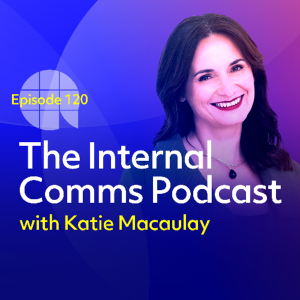
Episode 120 – Walk the line – how to stay in sync
June 11, 2025
In this episode of The Internal Comms Podcast, host Katie Macaulay sits down with alignment strategist and leadership coach Zora Artis to explore a crucial question: how can intern...
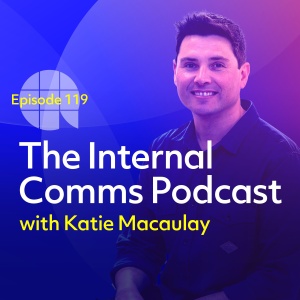
Episode 119 – The suite spot – Microsoft minus the mayhem
May 28, 2025
If the platforms you use at work were built by Microsoft, this episode is essential listening. Katie is joined by Alex Graves, Chief Visionary Officer at Silicon Reef — the peop...

Episode 118 – Satirising the spin – a bullsh*t investigation
May 14, 2025
If you have ever found yourself circling back, touching base, breaking down silos or leveraging strategic synergies — then these guests are speaking your language. Charles Firth...
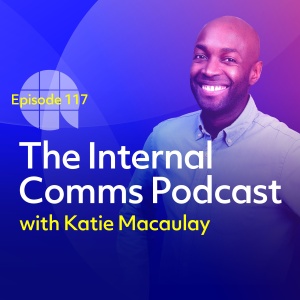
Episode 117 – From humanising a prime minister to empowering the quietest voices
May 12, 2025
What does it take to make one of the most scrutinised leaders in the world feel relatable? And how do we build internal comms that truly include everyone — especially the quieter...

Episode 116 – How to build a remarkable career without a plan
April 7, 2025
Fred Cook’s career proves success doesn’t require a straight line. Now Chairman Emeritus of global PR agency Golin, Fred has spent 35+ years advising world-famous brands – Am...

Episode 115 – Curiosity, creativity & the imposter myth
March 26, 2025
Inspiration is everywhere when you stay curious. That’s the thread running through this episode of The Internal Comms Podcast, where Katie Macaulay welcomes communication, creati...
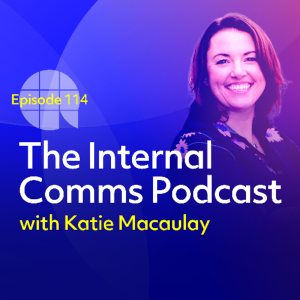
Episode 114 – The credibility code: Become the leader your team deserves
March 12, 2025
What does it mean to be a credible leader? And just how important is that credibility to your team? In this episode of The Internal Comms Podcast, host Katie Macaulay welcomes back...

Episode 113 – Soft skill? Think again: The hard truth about storytelling
February 26, 2025
In this episode of The Internal Comms Podcast, host Katie Macaulay welcomes Jeremy Connell-Waite, Global Communications Designer for IBM, an acclaimed speechwriter and storyteller,...

Episode 112 – From intent to impact: take charge of your career
February 20, 2025
We’re back for season 13 of The Internal Comms Podcast and to kick things off, host Katie Macaulay is joined by Eduvie Martin. Eduvie is Group Communications and Engagement Manag...

Season 12 – 2024 Christmas Special: nine gifts from the archive
December 18, 2024
In this episode, we mark a big milestone with a gift-wrapped edition of the Internal Comms Podcast. It’s six years since the show launched and, in this Christmas special, host K...
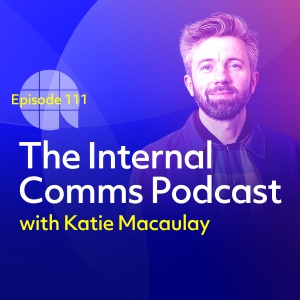
Episode 111 – A creative leader's blueprint for brilliance
December 4, 2024
This week on The Internal Comms Podcast, host Katie Macaulay is joined by a very special guest – AB's creative director, Joel O’Connor. Joel has been with AB for well over a de...
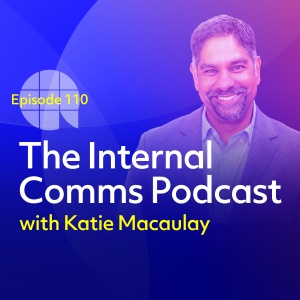
Episode 110 – Navigating the shifting digital landscape
November 20, 2024
This week on The Internal Comms Podcast, host Katie Macaulay is joined by co-founder of Local Wisdom, tech expert and comms leader Pinaki Kathiari. With his rare passion for both t...
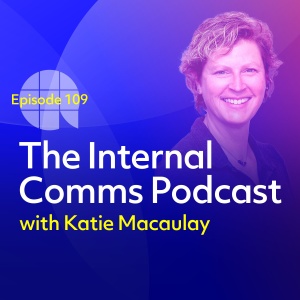
Episode 109 – The business of belonging: A new approach to DEI
November 6, 2024
We all deserve the opportunity to thrive at work. We deserve equal opportunity. We deserve to feel valued and included. That’s what diversity, equity and inclusion (DEI) is all a...
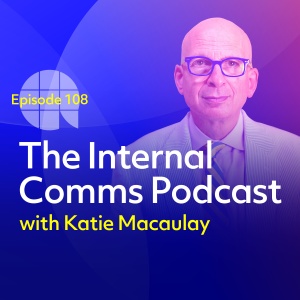
Episode 108 – Seth Godin rewrites the rules of internal communication
October 23, 2024
In this episode, Katie Macaulay is joined by author and influential blogger, Seth Godin. Seth was top of Katie’s guest wish list when The Internal Comms Podcast launched five ye...

Episode 107 – Beyond words: A blueprint for more impactful, immersive IC
October 9, 2024
In this episode of The Internal Comms Podcast, host Katie Macaulay welcomes international internal comms consultant and strategist Monique Zytnik to the hot seat. Monique is the au...

Episode 106 – School of thought: Inside Matt Tidwell’s comms curriculum
September 25, 2024
In this episode of The Internal Comms Podcast, host Katie Macaulay welcomes Matt Tidwell to the hot seat. Matt is a consultant, communicator and educator, and has led comms agencie...
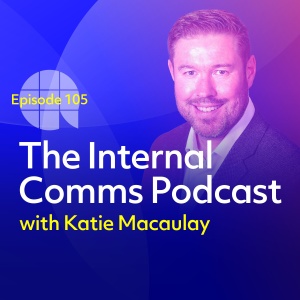
Episode 105 – Reaching the peak of success: IC at Iron Mountain
September 11, 2024
We’re back for Season 12 of The Internal Comms Podcast, and in this first episode, host Katie Macaulay is joined by Senior Director of Corporate Communication at Iron Mountain, N...
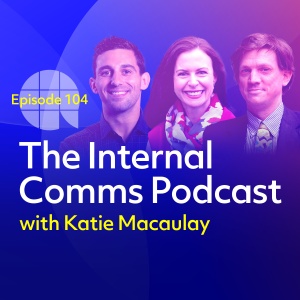
Episode 104 – Communications excellence in times of rapid change
July 31, 2024
McKinsey & Company is one of the world’s most renowned strategic management consultancies. With a mission of striving for “change that changes everything”, its global team of...
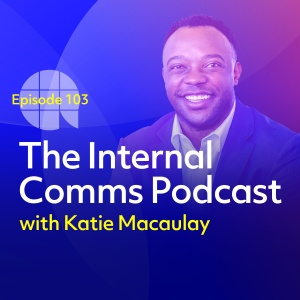
Episode 103 – Say the thing now: Candid conversations at Reddit
July 10, 2024
On a platform where the candid and the curious are king, how do you make sure what’s inside reflects what’s on the outside? Meet Sean Langston, Jr., Head of Internal Communicat...
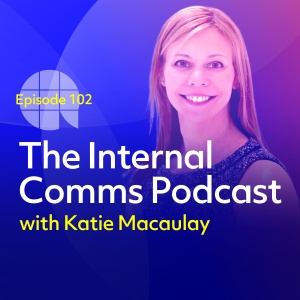
Episode 102 – The sound of success: IC at Spotify, Mastercard and beyond
June 26, 2024
Ever been curious about how some of the biggest brands in the world tackle their internal communication challenges? Well look (or listen) no further. Kerri Warner, this week’s gu...
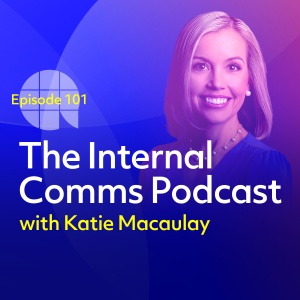
Episode 101 – From complex to clear: Elevate your presentations
June 12, 2024
As internal communicators, empowering leaders to clearly communicate business strategy, important updates and company values is a valued skill. How can we inspire colleagues and le...
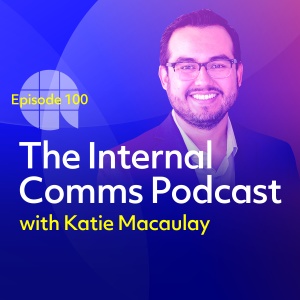
Episode 100 – Meet the super-connector behind #CommsJobs
May 29, 2024
After years running an internal communications team, Daniel Mendez emigrated from Chile to the U.S., where he faced a host of barriers to success. A language barrier. A small or no...

Episode 99 – The communicator’s communicator
May 15, 2024
In this episode of The Internal Comms Podcast, host Katie Macaulay is joined by Linda Zebian. The very first Director of Communications at PR management platform Muck Rack, Linda s...
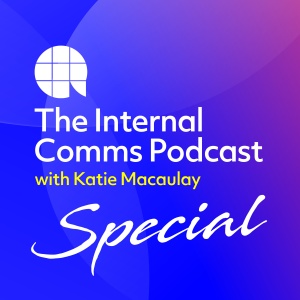
Exclusive reveal: Katie’s IC masterclass
May 1, 2024
Join us for a special episode of The Internal Comms Podcast as host Katie Macaulay announces the imminent launch of her unique on-demand masterclass. With more than three decades ...
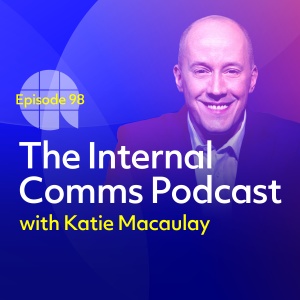
Episode 98 – How to build a powerful personal brand
April 17, 2024
This week on The Internal Comms Podcast, host Katie Macaulay is joined by serial entrepreneur, author, keynote speaker and business mentor Chris Ducker. Chris is a renowned expert ...

Episode 97 – Leaving the ladder down: helping IC pros step up
April 3, 2024
In this episode of The Internal Comms Podcast, host Katie Macaulay welcomes back the show’s first-ever guest, Rachel Miller. Rachel is an internationally recognised internal com...
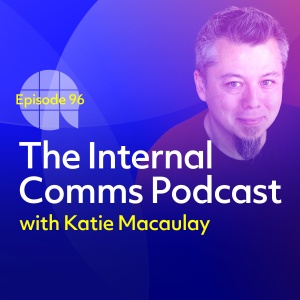
Episode 96 – Inclusion in action: Kindness is the keystone
March 20, 2024
This week on The Internal Comms Podcast, host Katie Macaulay is joined by Global Belonging, Equity and Impact Consultant, and self-styled ‘human-centric technologist’, Bob Wata...
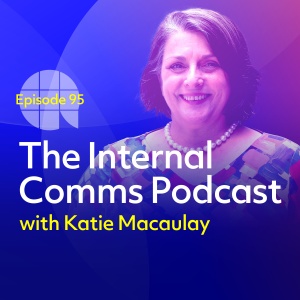
Episode 95 – Mastering your approach to strategic communication
March 6, 2024
This week on The Internal Comms Podcast, host Katie Macaulay is joined by award-winning marketing and communications expert Danielle Bond. Recently retired from corporate life, Da...
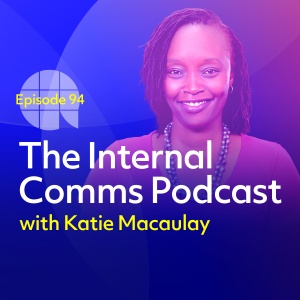
Episode 94 – The stories that shape us
February 21, 2024
In this episode of The Internal Comms Podcast, host Katie Macaulay is joined by leadership communications coach and co-founder of Engage Kenya, Agatha Juma. Agatha credits an emba...
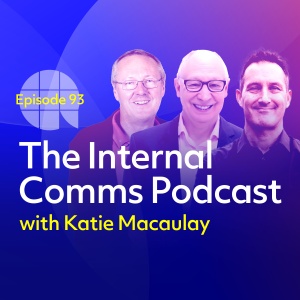
Episode 93 – The sound of success: Why it pays to listen to employees
February 7, 2024
We’re back for Season 11 of The Internal Comms Podcast! And kicking us off with a very special episode, this week host Katie Macaulay is joined by not one, not two, but three gue...
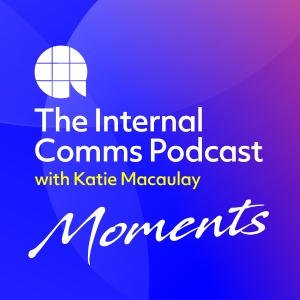
Moment 35 – The four Cs of content: How internal communicators can create comms that land
January 31, 2024
Looking for tips on creating internal communications that land – and stick? In this Moment from The Internal Comms Podcast, Steve Crescenzo shares a few things you absolutely mus...
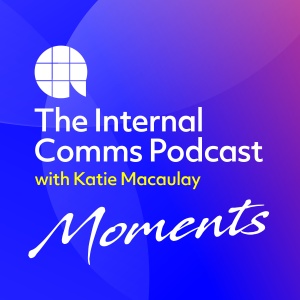
Moment 63 – Are you listening? The power of questions in leadership: Mike Roe
January 24, 2024
“I realised I was probably a pretty crap listener,” Mike Roe tells Katie Macaulay in this Moment from The Internal Comms Podcast. We often go to leaders and start by asking th...
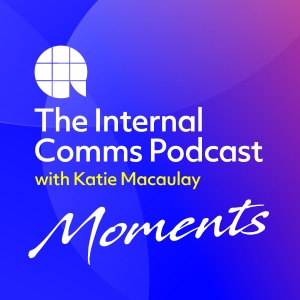
Moment 57 – Language matters: Building two-way engagement at IKEA
January 17, 2024
At IKEA, choosing the right words when communicating with the workforce is everything. Guy Britt, IKEA’s Global Head of Co-worker Comms, tells Katie Macaulay the use of ‘co-wo...

Episode 92 – Revolution coming: How AI is transforming internal comms
December 20, 2023
If you have ever attended one of Shel Holtz’s presentations, you will know that, more often than not, it’s standing room only. Shel has a remarkable ability to anticipate what'...
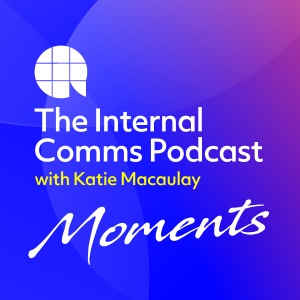
Moment 61 – Human-centric businesses do better: Victoria Dew
December 6, 2023
Does your approach to internal communication have the human touch? It’s essential to the humans you employ, says Victoria Dew, CEO of Dewpoint Communications and an internal com...
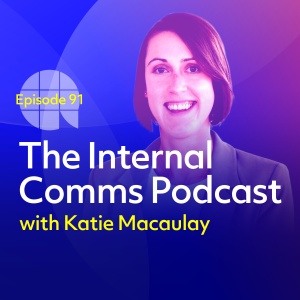
Episode 91 – How to build a one-person IC powerhouse
November 22, 2023
Ever feel like, as an internal communicator, you’re fighting an uphill battle all by yourself? This week’s guest on The Internal Comms Podcast has exactly what you need. Host ...
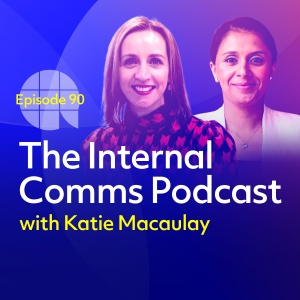
Episode 90 – A shared vision: ED&I and IC in action
November 8, 2023
This week on The Internal Comms Podcast, host Katie Macaulay is joined by Sim Sian, Head of Equality, Diversity and Inclusion at Mitie, and Yvonne O’Hara, formerly Mitie’s Grou...

Episode 89 – Netflix-style IC: Snackable, on-demand and authentic
October 25, 2023
In this episode of the Internal Comms Podcast, host Katie Macaulay is joined by Access Group’s Global Head of Communications and Engagement, Paul Downey. Paul caught Katie’s ...

Episode 88 – It’s fixable: How to tackle hard problems
October 11, 2023
In this episode of the Internal Comms Podcast, host Katie Macaulay is joined by Anne Morriss. Anne is an entrepreneur, author, public speaker, and the Executive Founder of the Lea...
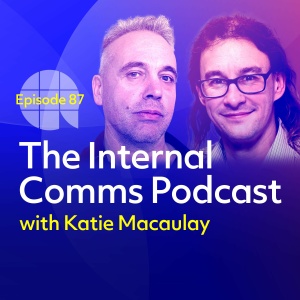
Episode 87 – Tracing the legacy of internal comms
September 27, 2023
It’s often said we must understand the past to build the future, and that sentiment sits at the very heart of this episode. This week on The Internal Comms Podcast we welcome pr...
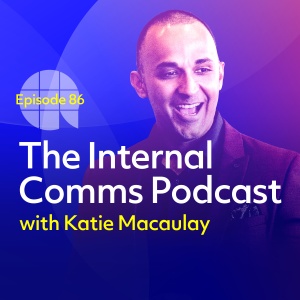
Episode 86 – How to crush your next public speaking gig
September 13, 2023
Season 10 of the Internal Comms Podcast kicks off with one of Katie’s most compelling conversations yet. Shil Shanghavi is a public speaking specialist, storyteller and head of...

Coming soon: Season 10 of The Internal Comms Podcast
September 6, 2023
Our summer break is drawing to a close, Katie has dusted off her mic and we’re ready to launch Season 10 of The Internal Comms Podcast! This season, we’ll be welcoming more o...

Moment 18 – 3% of employees are driving 90% of conversations: Mike Klein
August 30, 2023
In this moment, we catch up with Mike Klein, former political consultant, modern-day communications stalwart, and two-time guest on the Internal Comms Podcast. Mike breaks down h...
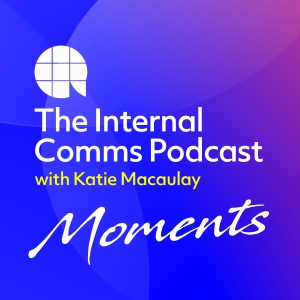
Moment 17 – How we create meaning: Sue Dewhurst & Liam FitzPatrick
August 23, 2023
What’s our one true purpose as internal communicators? It’s the question we’re all seeking the answer to. This moment takes us back to when Katie first welcomed Sue Dewhurs...

Moment 13 – The message must change at each leadership level: Dr Kevin Ruck
August 16, 2023
If there’s one thing we’re clear about at AB, it’s that communication should not be a one-way street. And that’s what this moment is about. We head back to Episode 13, w...

Moment 06 – On tolerance, kindness and being enough: Henry Normal
August 9, 2023
As communicators, we could often do with slowing things down a little. In this moment, Henry Normal – author and co-founder of production company Baby Cow, which he founded with ...
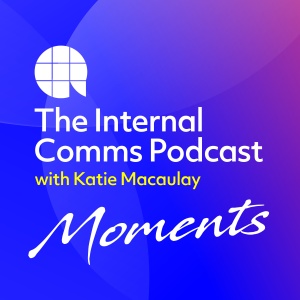
Moment 01 – What happens inside is reflected outside: Rachel Miller
August 2, 2023
Have you heard of an inside-out approach to communication? It’s no secret that today’s internal comms messages seep into the world outside the office walls. After all, anythi...
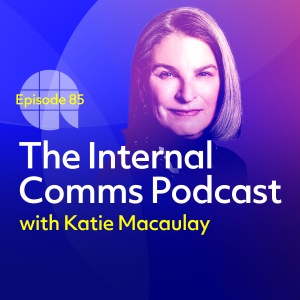
Episode 85 – Lessons from a trailblazer
July 26, 2023
We’re ending Season 9 of the Internal Comms Podcast with a bang this week, as Sally Susman takes to the hot seat for her second appearance. Sally is Executive Vice President an...
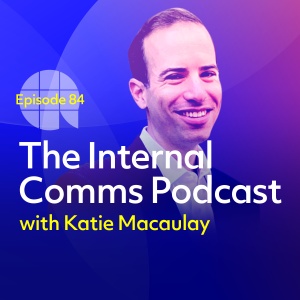
Episode 84 – Ethics in action: Insights from a global compliance leader
July 12, 2023
In modern business, integrity is non-negotiable. As legislation ramps up in lockstep with colleague and customer demands, operating an ethical business in line with global regula...

Episode 83 – ESG: How IC can drive the agenda
June 28, 2023
Define ESG… Well, it stands for environment, social and governance. But can you really define what ESG actually is? Put very simply, ESG is a set of criteria used to evaluate a ...
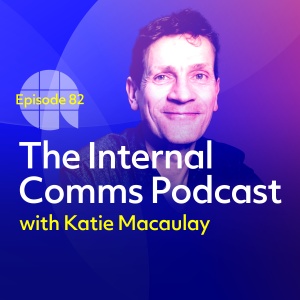
Episode 82 – The truth about resilience
May 31, 2023
It seems everyone’s talking about resilience, the ability to bounce back from misfortune or adversity. But as Bruce Daisley explains to host Katie Macaulay, there’s something w...
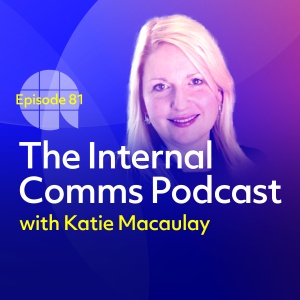
Episode 81 – Unilever: Inside a global success story
May 17, 2023
With over 130,000 colleagues, and a 100-year history, Unilever is one of the world’s largest consumer goods companies. And this week on the Internal Comms Podcast, we get a peek ...
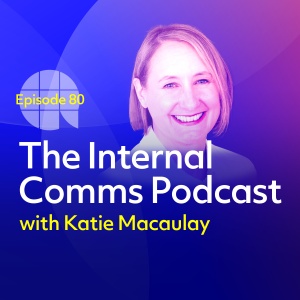
Episode 80 – The inside track on comms at Mercedes F1
May 3, 2023
“The days we fail are the days our competitors live to regret,” said the late, great Niki Lauda. And that’s what this episode of the Internal Comms Podcast is all about. Thi...

Episode 79 – Lifting the lid on comms consultancy
April 19, 2023
Ever considered what it takes to become an effective communications consultant? Then this week’s episode of The Internal Comms Podcast is for you. Host Katie Macaulay welcomes Si...

Episode 78 – Comms with courage
April 5, 2023
This week on The Internal Comms Podcast, host Katie Macaulay welcomes Audacity’s Jason Anthoine. Jason has spent three decades working in internal communication, employee experie...
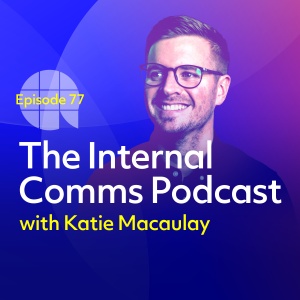
Episode 77 – Here for the culture
March 22, 2023
This week on The Internal Comms Podcast, host Katie Macaulay welcomes culture-chameleon Shane Hatton. Shane is many things – author, international speaker, trainer, leadership co...

Episode 76 – Employee experience: For the people by the people
March 8, 2023
This week on The Internal Comms Podcast, host Katie Macaulay welcomes Nicholas Wardle. Nicholas is Head of Employee Experience at Brand Experiences, and co-author of ‘Monetising ...

Episode 75 – Inside the world’s most famous corner shop
February 22, 2023
This week on The Internal Comms Podcast, host Katie Macaulay welcomes Sam Bleazard. Sam’s role as Employer Brand Content Producer takes him behind the scenes of ‘the world’s ...

Episode 74 – Culture with sticking power
February 8, 2023
The Internal Comms Podcast is back for Season 9! To kick off this season, we welcomed BizJuicer’s Andy Goram to the hot seat. Andy’s passion for building businesses ‘from t...

Season 8: In the rear view mirror
February 1, 2023
With Season 9 of The Internal Comms Podcast right around the corner, host Katie Macaulay has taken the opportunity to reflect on the wisdom and insight shared over our latest seaso...
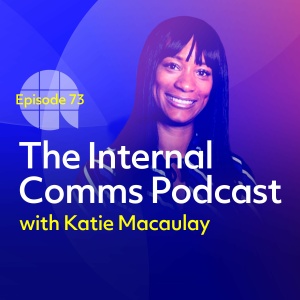
Episode 73 – Forging your own path
December 21, 2022
The season 8 finale features Jennifer Thomas, Head of Communications for the Data & Analytics branch of the London Stock Exchange Group. Born in London to Guyanese parents, Jennif...
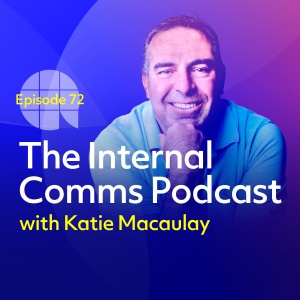
Episode 72 – Making your way to the top
December 7, 2022
Episode 72 of The Internal Comms Podcast sees host Katie Macaulay joined by Adrian Cropley, CEO and founder of Cropley Communication and the Centre for Strategic Communication Exce...

Episode 71 – Effective comms starts with knowing yourself
November 23, 2022
This week’s guest on The Internal Comms Podcast is Joanna Parsons, Head of Internal Communications & Culture at Teamwork. Joanna made Irish history as the first ever Head of Inte...
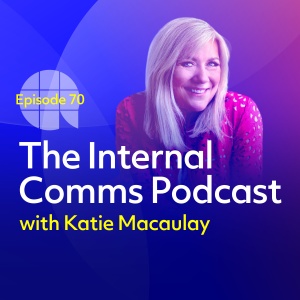
Episode 70 – Reaching across the aisle
November 9, 2022
Shelby Scarbrough, author of 'Civility Rules! Creating a Purposeful Practice of Civility', shares her deep insight and experience ‘reaching across the aisle’ on episode 70 of T...

Episode 69 – Measuring what matters – actions not feelings
October 26, 2022
Episode 69 of The Internal Comms Podcast sees IC heavyweight Mike Klein return to the hot seat. An internal and social communication consultant based out of Reykjavik, Mike is help...

Episode 68 – Host in the hot seat: Reflections on 250,000 plays
October 12, 2022
In this very special episode of The Internal Comms Podcast, the tables have turned. Katie Macaulay is in the hot seat, and AB’s Senior Content Editor Freddie Reynolds takes over ...
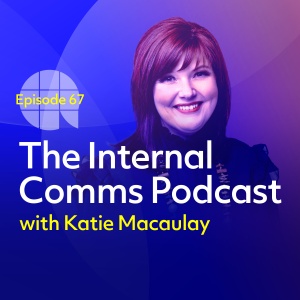
Episode 67 – The ABC of research: Ask, believe, change
September 28, 2022
In this episode of The Internal Comms Podcast, host Katie Macaulay invites qualitative research expert Mari Lee to sit in the hot seat. Mari’s specialism is in ‘development com...
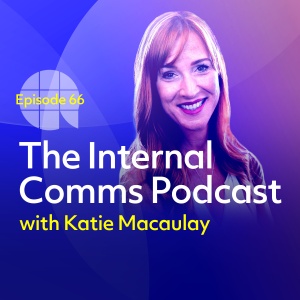
Episode 66 – Combatting IC isolation
September 14, 2022
The Internal Comms Podcast is back for what promises to be an incredible Season 8! In this kick-off episode, host Katie Macaulay welcomes ICology’s Vice President of Community an...

Season 7: The rewind episode
September 7, 2022
The countdown is on, and The Internal Comms Podcast will be returning from its summer break with Season 8 imminently. And while its eighth instalment promises wisdom unbound from a...

Episode 65 – Remote but not unreachable
June 22, 2022
In the final episode of season 7 of The Internal Comms Podcast, host Katie Macaulay speaks with Lily Goodman D’Amato, Delivery Trainer at US-based digital pharmacy Medly. Lily b...

Episode 64 – Releasing your inner sceptic
June 8, 2022
In the latest episode of The Internal Comms Podcast, host Katie Macaulay speaks with Martin Flegg, founder and co-owner of The IC Citizen internal communications consultancy. With...
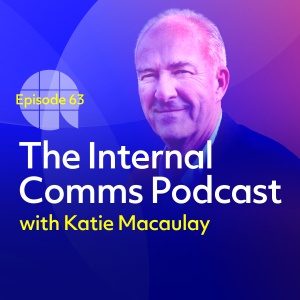
Episode 63 – Lessons in leadership
May 25, 2022
In episode 63 of The Internal Comms Podcast, host Katie Macaulay meets Mike Roe, who had a 28-year career in the police force and is now CEO of Tensense, a data insights company. ...
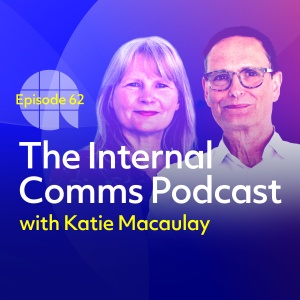
Episode 62 – Textbook IC: rewriting comms for a new era
May 11, 2022
In the latest episode of The Internal Comms Podcast, host Katie Macaulay speaks with the duo who wrote the book on internal communications – literally. Sue Dewhurst has worked i...

Episode 61 – Embracing the messiness of being human
April 27, 2022
In this week’s episode of The Internal Comms Podcast, host Katie Macaulay sits down with Victoria Dew, founder and CEO of Dewpoint Communications. Her firm is focused on helping ...
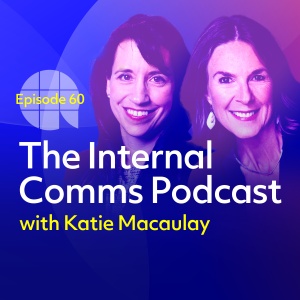
Episode 60 – How to have better conversations
April 13, 2022
In this week’s episode of The Internal Comms Podcast, host Katie Macaulay sits down with Jackie Stavros and Cheri Torres, co-authors of Conversations Worth Having, Using Apprecia...

Episode 59 – Strategy & IC: A masterclass in collaboration
March 30, 2022
In this episode of The Internal Comms Podcast, host Katie Macaluay looks into the dynamic between internal comms and strategy – at its best a symbiotic relationship that drives t...
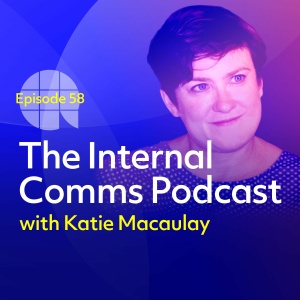
Episode 58 – The state of IC: what’s behind the numbers?
March 16, 2022
In episode 58 of The Internal Comms Podcast, we dissect the results of the latest State of the Sector report, the definitive global survey of the internal communication landscape, ...
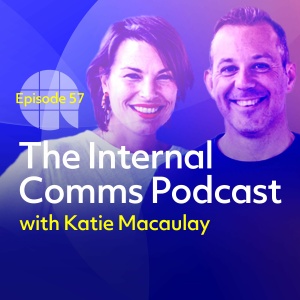
Episode 57 – Unboxing internal comms at IKEA
March 2, 2022
In episode 57 of The Internal Comms Podcast, listeners can take a peek inside the world of IC at IKEA, as host Katie Macaulay chats with a dynamic duo from the multinational furnit...
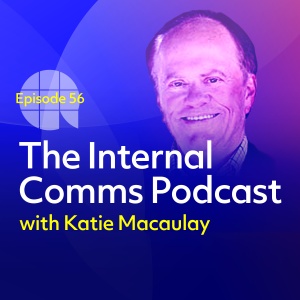
Episode 56 – IC at the sharp end
February 16, 2022
In this first episode of season 7 of The Internal Comms Podcast, host Katie Macaulay talks to Jim Shaffer, an internationally recognised business adviser, leadership coach, author ...
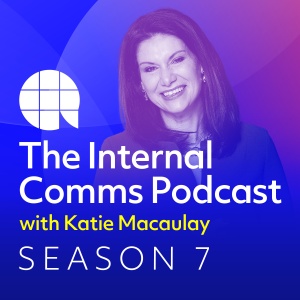
Leading Lights – Highlights From Season 6
February 9, 2022
Get ready to tune in to our next season of The Internal Comms Podcast. While Season 7 promises an amazing array of guests, this special episode highlights some of the best moments ...
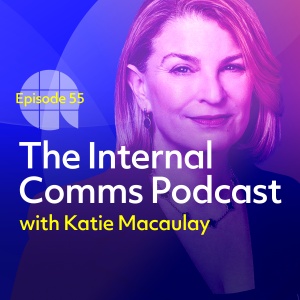
Episode 55 – Mission Possible
December 1, 2021
In the final episode of season 6 of The Internal Comms Podcast, host Katie Macaulay speaks to Sally Susman, Executive Vice President and Chief Corporate Affairs Officer at Pfizer. ...
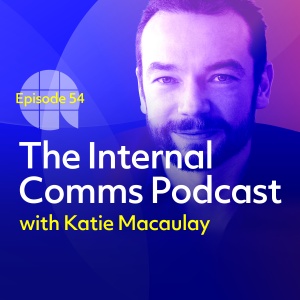
Episode 54 – Brain care: Mastering your mind
November 17, 2021
In the sixth episode of season 6 of The Internal Comms Podcast, host Katie Macaulay talks to Phil Dobson, founder of BrainWorkshops and author of The Brain Book: How to Think and W...

Episode 53 – Suicide Prevention: Reflecting on an award-winning campaign
November 3, 2021
***The content in this episode of The Internal Comms Podcast may be triggering for those who have experience of suicide.*** In the fourth episode of season 6 of The Internal Comms...

Episode 52 – How do you create comms with purpose?
October 20, 2021
In the fourth episode of season 6 of The Internal Comms Podcast, host Katie Macaulay catches up with Maliha Aqeel, Director of Global Communications and Digital Channels at Fix Net...
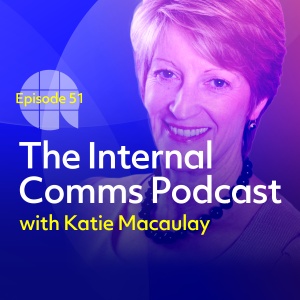
Episode 51 – Why are we here? How purpose and values drive healthy cultures
October 6, 2021
In the third episode of season 6 of The Internal Comms Podcast, host Katie Macaulay catches up with communications expert and IABC Fellow Jane Mitchell. Jane began her career with...

Episode 50 – A guru’s guide to internal podcasts
September 22, 2021
In the second episode of season 6 of The Internal Comms Podcast, host Katie Macaulay talks to Brian Landau, an authority in podcasting and expert on all things audio content creati...
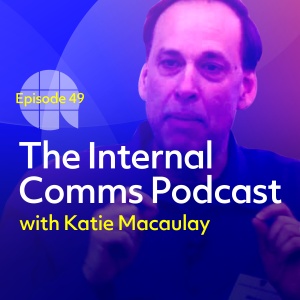
Episode 49 – Engagement: how it started, how it's going
September 8, 2021
In this first episode of season 6 of The Internal Comms Podcast, host Katie Macaulay talks to the father of employee engagement, organisational psychologist Professor William Kahn....
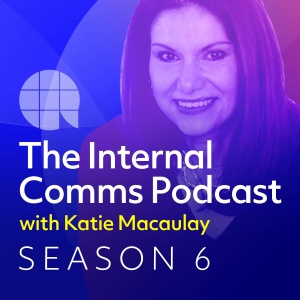
Industry experts – highlights from Season 5
September 1, 2021
The curtain is about to go up on the new season of The Internal Comms Podcast, with some fantastic guests joining host Katie Macaulay to talk about all things communication. For t...
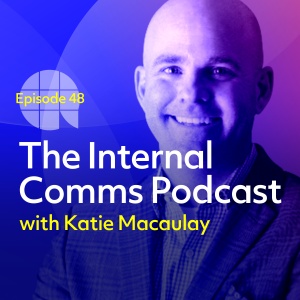
Episode 48 – Changing minds: using behavioural science in IC
May 12, 2021
It has always been Katie Macaulay’s goal for The Internal Comms Podcast to help improve the way organisations communicate with their people, and this week she does so by explorin...
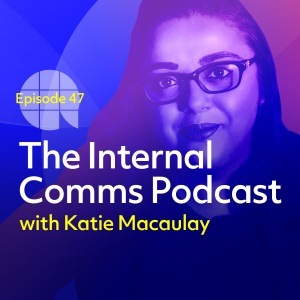
Episode 47 – Conversation with a comms rebel
April 28, 2021
Katie Macaulay’s guest this week is a leading light in efforts to advance the careers of under-represented groups in IC. Advita Patel is a qualified coach, mentor, public speake...
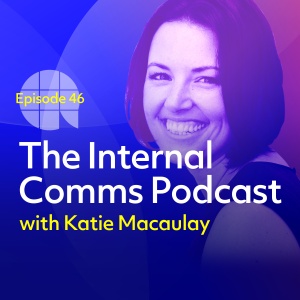
Episode 46 – Influential Internal Communication
April 14, 2021
This episode sees the return of the brilliant business communications strategist, international public speaker and podcast host Jenni Field. The immediate past chair of the Charte...
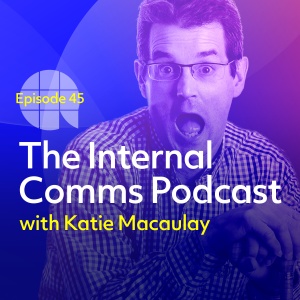
Episode 45 – Sharing the magic
March 31, 2021
The life and career of this week’s guest has been a literal roller coaster. Mark Webb fell into PR and media relations by chance, after spotting a job ad for the new Eurodisney ...

Episode 44 – How to prove your presence
March 17, 2021
Katie Macaulay’s guest for episode 44 of The IC Podcast is Canadian comms expert Prarthna Thakore. After beginning her career in Calgary and then moving to London, Prarthna has ...
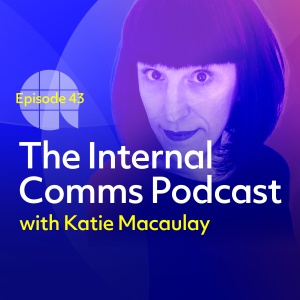
Episode 43 – Kate Jones on the state of our sector
March 3, 2021
Every year since 2008, internal comms pros have responded to the Gallagher State of the Sector report. Because it’s been running for 13 years, and because similar questions are a...

Episode 42 – Once Upon A Time In IC
February 17, 2021
Katie Macaulay kicks off Season 5 of The IC Podcast with a riveting conversation with business storytelling specialist Gabrielle Dolan. Gabrielle is a highly sought-after internat...

Looking back, looking forward: highlights from Season 4
February 10, 2021
With the new season of The Internal Comms Podcast just around the corner, we wanted to whet your appetite with a selection of the best bits from Season 4. For this special best-of...
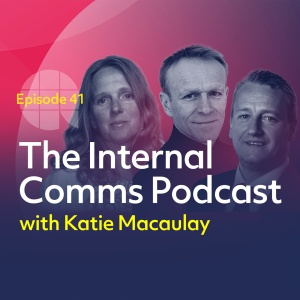
Episode 41 – At the heart of the crisis: NHS comms during Covid-19
December 23, 2020
The NHS has never been far from our hearts and minds over the last few months. As the national jewel in the UK’s crown, the National Health Service has battled many difficulties ...

Episode 40 – Founding fathers – building the first IC agency
December 17, 2020
What prompted the creation of the first IC agency back in 1964 and what convinced those first chief executives that they needed external help communicating with their employees? W...
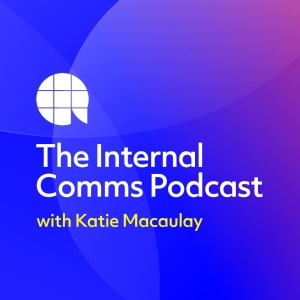
Coming soon in season 4
December 9, 2020
Coming soon in season 4 of The Internal Comms Podcast
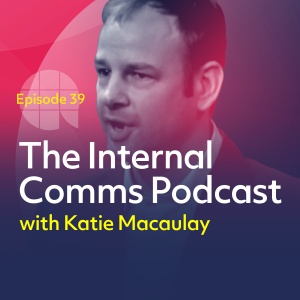
Episode 39 – Evidence-based IC
November 25, 2020
Recent research shows measurement is particularly challenging for many internal comms professionals. Katie’s guest on this episode of The Internal Comms Podcast is Benjamin Ellis...

Episode 38 – The secret thoughts of successful people
November 11, 2020
Amid the turmoil of 2020, with IC pros thrown into the spotlight as we strive to keep colleagues informed and connected, it’s not surprising that many of us are feeling a degree ...
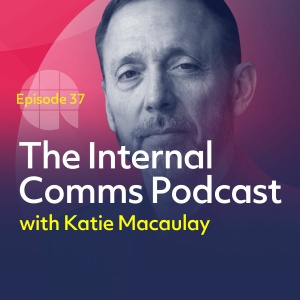
Episode 37 – The art of negotiation
October 28, 2020
If you want to take your communication skills to the next level, then this episode of The Internal Comms Podcast is for you. Katie’s guest is a formidable negotiator and expert ...

Episode 36 – Navigating the digital landscape
October 14, 2020
In this episode of The Internal Comms Podcast we meet digital expert Frank Wolf. Frank spent seven years as a business consultant at Accenture. Then at T Mobile, he was responsible...

Episode 35 – How to do less, but do it better
September 30, 2020
In this episode of The Internal Comms Podcast we meet Steve Crescenzo, a witty, straight-talking and charismatic speaker, workshop leader and coach from Chicago, USA, who has spent...

Episode 34 – Cross-cultural comms
September 16, 2020
The Internal Comms Podcast is now in its fourth season – and to kick it off Katie sat down with Tasneem Chopra for some honest and open conversation. The self-styled “professi...
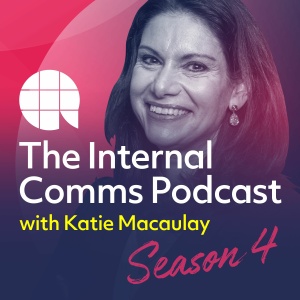
Choice cuts: highlights from Season 3 of The IC Podcast
September 2, 2020
Before the curtain lifts on Season 4 of The IC Podcast, we wanted to leave you with some food for thought from Season 3. And what a season it was; we had a whole host of remarkabl...
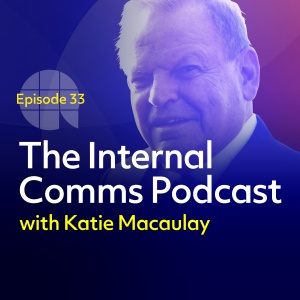
Episode 33 – IC’s founding father
July 8, 2020
The goal of this podcast is to bring you meaningful, in-depth conversations with people who are helping to shape the world of internal communication: practitioners, leaders, author...
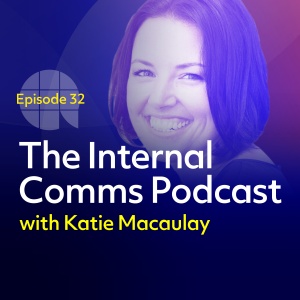
Episode 32 – Leadership in unprecedented times
June 24, 2020
President of the Chartered Institute of Public Relations (CIPR), Jenni Field has more than 16 years’ experience in communications. She is the founder and director of Redefining C...
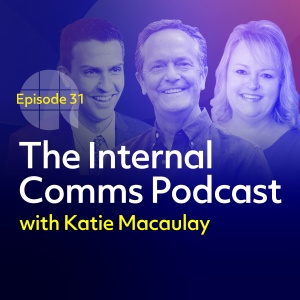
Episode 31 – What's next? IABC roundtable on the impact of Coronavirus
June 10, 2020
The Internal Comms Podcast has gone truly global with our latest episode featuring three speakers from three countries. In episode 31 Katie tables a roundtable discussion with Jen...

Episode 30 – Your biggest, best, boldest self
May 27, 2020
Chief Executive of the Office for Nuclear Regulation (ONR), Adriènne Kelbie has an exceptional understanding of the true power of communication and engagement. The first woman to ...

Episode 29 – Crisis communication at the coalface
May 13, 2020
Katie’s guest this week is someone who is no stranger to crisis communication. Amanda Coleman was the Director of Corporate Communication at Greater Manchester Police when, on M...
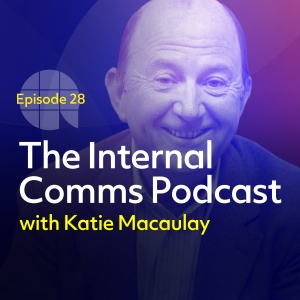
Episode 28 – The Godfather of IC
April 29, 2020
Katie’s guest this week is one of the world’s leading authorities on internal comms and the management of change: Bill Quirke. As managing director of IC consultancy Synopsis,...
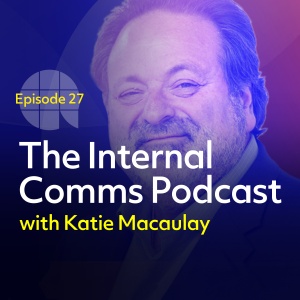
Episode 27 – Stepping up in a Crisis
April 14, 2020
This week Katie speaks to renowned communicator Shel Holtz. As listeners continue to grapple with keeping workforces informed, galvanised and feeling connected during the corona cr...
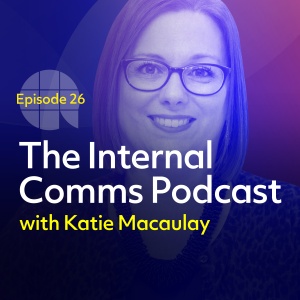
Episode 26 – How to thrive in IC (Part II)
April 1, 2020
This episode is recorded as the majority of the UK is in lockdown while the country attempts to flatten the curve of the COVID-19 pandemic. Katie Macaulay’s guest, Rachel Miller...
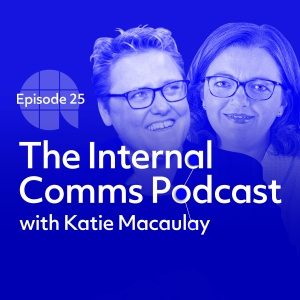
Episode 25 – Crisis Communications: Covid-19 Special
March 25, 2020
Katie Macaulay recorded this special episode on Friday 20 March 2020 in response to the rapidly developing situation surrounding the Covid-19 pandemic. Her guests to talk all thin...
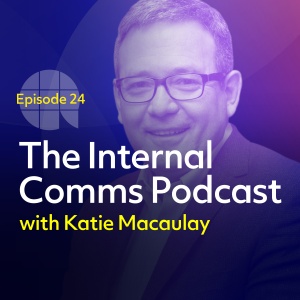
Episode 24 – A view from the top
March 18, 2020
In this episode of The Internal Comms Podcast, Katie puts her first CEO in the hotseat: Marc Barone. Marc is chief executive for continental Europe at AECOM. This Fortune 500 comp...

Episode 23 – Courage, confidence and communication
March 4, 2020
In this episode of The Internal Comms Podcast Katie talks to one of world’s most qualified communicators, Priya Bates, from Canada. Priya has an Accredited Business Communicator...
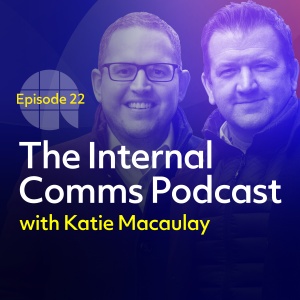
Episode 22 – State of the Sector
February 19, 2020
State of the Sector is the longest-established and most in-depth survey of the internal communication profession, based on responses from more than 1,000 professionals around the w...
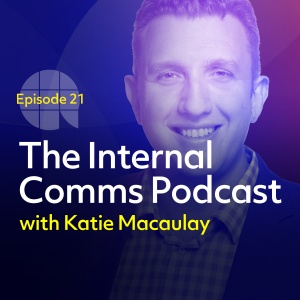
Episode 21 – The cheerleader for IC
February 5, 2020
During Seasons One and Two we covered a lot of ground in IC and beyond. As we begin Season Three, brace yourself for more fascinating insights as we delve into the very heart of co...
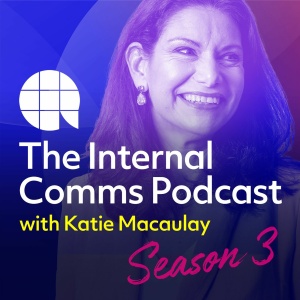
The highlight reel – nuggets of wisdom from Season 1 and 2 of The IC Podcast
January 29, 2020
Since the launch of The Internal Comms Podcast, host Katie Macaulay has interviewed more than 20 fascinating guests from the world of IC and beyond. Now, as we gear up for Season ...
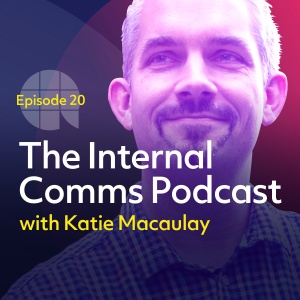
Episode 20 – Advocacy in action
December 18, 2019
Katie’s guest this week is Keith Lewis, UK Social Media and Social Business Manager for Zurich Insurance – one of the world’s largest insurance groups with 55,000 employees i...

Episode 19 – The appliance of neuroscience
December 4, 2019
Katie Macaulay’s guest this week is a neuroscientist with extensive experience in the field of organisational change. Hilary Scarlett began studying the brain in 2009 after read...
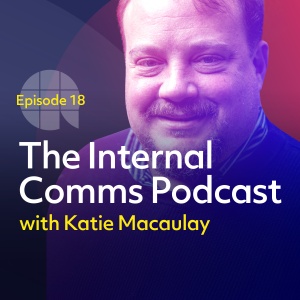
Episode 18 – Editing organisations
November 20, 2019
In this episode we get up close and personal with someone who helps improve the way we communicate at work. Mike Klein worked as a political consultant in the US, but for the past...

Episode 17 – Black Belt Thinking
November 6, 2019
As individuals, this week’s guests have impressive CVs. Sue Dewhurst is an experienced internal communicator who, for many years, has been training and coaching thousands of lea...
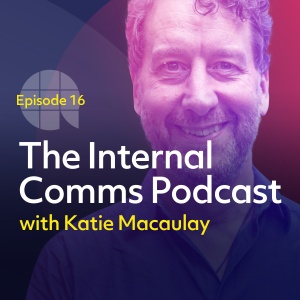
Episode 16 – A Passage to India
October 23, 2019
With this podcast now reaching listeners in 50 countries worldwide, host Katie Macaulay has chosen to go international for this episode. Her guest is creative services entrepreneu...
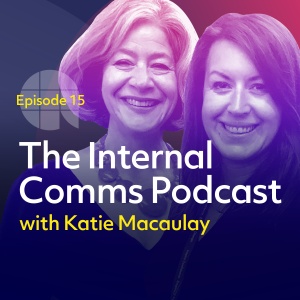
Episode 15 – The Power of Two
October 8, 2019
This week, Katie meets Claire Hyde and Louise Wadman, joint heads of IC at KPMG UK. Possibly the most senior IC job share in the country, Claire and Louise have more than 45 years...

Episode 14 – How to start a movement
September 24, 2019
Katie’s guest this episode is Nita Clarke – whose services to employee engagement have earned her an OBE from the Queen. Nita has a long and fascinating career. She co-authore...

Episode 13 – A check-up with the IC doctor
September 11, 2019
The Internal Comms Podcast is back with a new series of fortnightly conversations with leading lights from the world of internal communications, engagement and leadership. AB Mana...
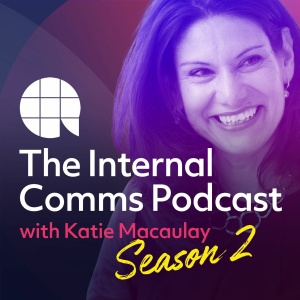
Season 02 Trailer
September 6, 2019
Season two of The Internal Comms Podcast is almost here!
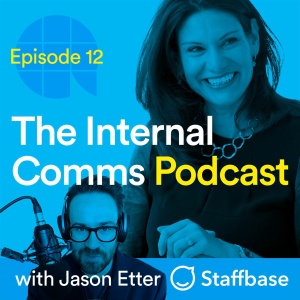
Episode 12 – Listen and learn: insights from 30 years in IC
July 24, 2019
In this extra special bonus episode of The Internal Comms Podcast, the tables are turned on Katie as she takes the spotlight as an interviewee. Posing the searching questions is J...

Episode 11 – Putting the soul back into Patisserie Valerie
June 25, 2019
For this special bonus episode of The IC Podcast, Katie interviewed Paolo Peretti, Managing Retail Director of Patisserie Valerie, in front of a live audience at AB Thinks Live, ou...
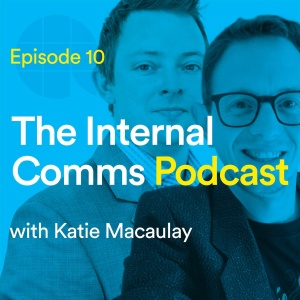
Episode 10 – Internal comms at the sharp end - recorded at IoIC live
May 21, 2019
For the final episode of season one, Katie Macaulay travels to Bath for IoIC Live and interviews two of the conference’s speakers, Martin Fitzpatrick and Matt Batten. Both Marti...

Episode 09 – How to win colleagues and influence people
May 7, 2019
Social influencer marketing is a new and rapidly growing means of getting your message out to your audience. It’s changed the face of advertising and has everyone from up-to-the-...

Episode 08 – The Joy of Work
April 23, 2019
Katie’s guest this week is an extremely versatile communicator. In his day job as European Vice President of Twitter, Bruce Daisley has overseen the development of one of the wor...
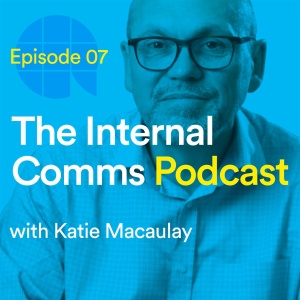
Episode 07 – What social purpose (really) means
April 9, 2019
Running the UK’s largest retail and financial services network with more branches than all of the UK’s banks and building societies put together, the Post Office is at the hear...

Episode 06 – The craft of communication
March 27, 2019
In episode six, Katie travels beyond the boundaries of internal comms to find out how to write more engagingly, tell better stories and use humour to deliver your message. And who ...
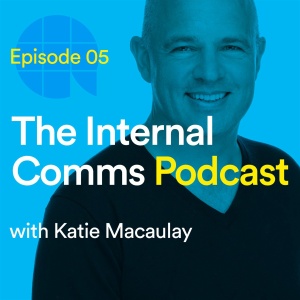
Episode 05 – Learning comms lessons from PR
March 13, 2019
In episode five, Katie aims to find out what internal communications can learn from external communications. So she sits down with ‘mister public relations’, Stephen Waddington...
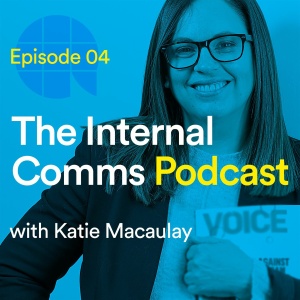
Episode 04 – What it means to be the voice of IC
February 27, 2019
The Institute of Internal Communication (IoIC) is the voice of the IC profession – dedicated to strengthening confidence, credibility and community. And on 12 March, the IoIC cel...
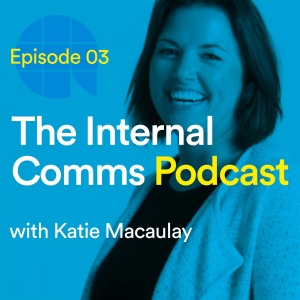
Episode 03 – What the State of the Sector report means for IC
February 13, 2019
Episode three lands as Gatehouse’s latest State of the Sector report is published. Katie invites Jenni Field, a tireless, high-profile personality of the IC landscape, to discus...
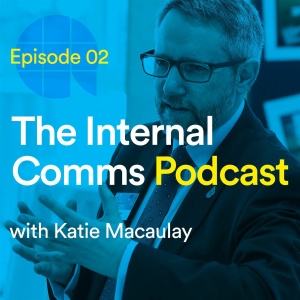
Episode 02 – What it takes to be an IC leader
January 30, 2019
Even if you’re only vaguely familiar with internal communications, Katie’s guest in episode two will no doubt be a name you recognise. In a career spanning 30 years, Russell G...

Episode 01 – How to thrive in IC
January 16, 2019
In the first episode of The Internal Comms Podcast, Katie meets Rachel Miller – a prolific blogger, educator, keynote speaker and one of the most respected voices in internal com...
